Paul van Yperen's Blog, page 413
July 15, 2014
Ada Svedin
German actress Ada Svedin (1894-1975) starred in several silent film operettas, produced and directed by Ludwig Czerny. He also became Svedin's husband.
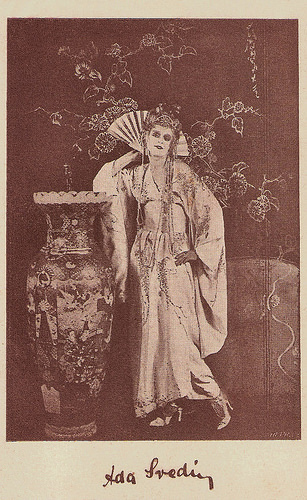
Dutch postcard. Photo: publicity still for Die blonde Geisha/The blonde Geisha (Ludwig Czerny, 1923).
Spotted By Chance
Ada Svedin was born in Hohensalza, Germany (now Inowrocław, Poland) in 1894 (according to IMDb in Berlin in 1900). Her father was a composer and musician.
Ada started her career as a secretary at the Deutsche Bank in Brussels, Belgium.
When she came to Berlin, film director Ludwig Czerny spotted her by chance. He engaged her for his films in which she from early on impersonated leading roles.
Among her first films were Er geniesst/He enjoys (1918), Die geborgte Villa/The borrowed villa (1918), Die Notbremse/The emergency brake (1918) and Wie die Grossen/As the great (1918), made for the production company of Oskar Einstein.
In 1919 Czerny engaged her for the female lead role in his Melodie des Herzens/Melody of the Heart (Willi Achsel, Ludwig Czerny, 1919) opposite Charles Willy Kayser.
That year, she also appeared with Kayser in Das Nachttelegramm/The night Telegram (Ludwig Czerny, 1919). She also had a part in Das Caviar-Mäuschen/The Little Caviar Mouse (Gerhard Dammann, 1919).
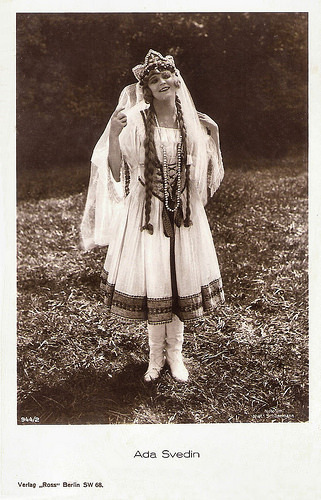
German postcard by Ross Verlag, no. 944/2, 1925-1926. Photo: Noto-Film / Schünemann.
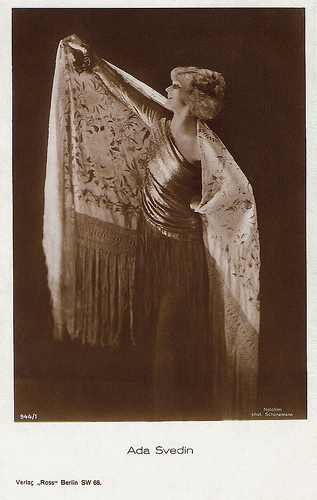
German postcard by Ross Verlag, no. 944/1, 1925-1926. Photo: Noto-Film / Schünemann.
The Czerny-Springefeld Method
Ada Svedin and her director married in 1919. Czerny founded the production company Noto-Film Gmbh and in the coming years, he directed and produced several silent film operettas starring his wife.
German Wikipedia : “Czerny had co-developed an invention (the so-called Czerny-Springefeld method) which copied a score sheet into the film negative. Thus the conductor and his orchestra could use this as a template for the cinematic musical passages; and singers in the cinema sang in sync with the lip movements the arias of the actors on the screen”
Svedin then played a countess in Das Kussverbot/The kiss ban (Ludwig Czerny, 1920).
In her next film Miss Venus (Ludwig Czerny, 1921), Charles Willy Kayser was her co-star again. Sunny boy Willy Fritsch made his film debut in a supporting part in this silent film operetta.
In Jenseits des Stromes/Beyond the stream (Ludwig Czerny, 1922), Svedin co-starred with Walter Janssen, but in Die blonde Geisha/The blonde Geisha (Ludwig Czerny, 1923), Kayser was her film partner once again.
In spite of the considerable effort of Czerny, Svedin and their Noto-Film, these films proved to be technically imperfect and also quite unsuccessful.
Svedin’s final silent operetta was Das Mädel von Pontecuculi/The Girl from Pontecuculi (Ludwig Czerny, 1924), again with Charles Willy Kayser as her co-star.
After this production Svedin retired from the film business. Noto-Film made one more film and then also stopped. Czerny produced some short documentaries during the 1930s.
Ada Svedin died in 1975 in her homeplace Berlin.
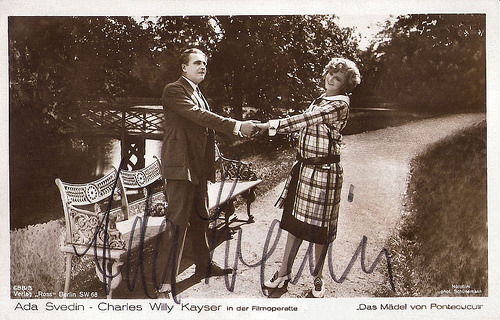
German postcard by Ross Verlag, no. 688/5, 1919-1924. Photo: Noto-Film / Schünemann. Publicity still for the silent operetta film Das Mädel von Pontecuculi/The Girl from Pontecuculi (Ludwig Czerny, 1924).
Sources: Thomas Staedeli (Cyranos), , Fimportal.de, Wikipedia (German) and .

Dutch postcard. Photo: publicity still for Die blonde Geisha/The blonde Geisha (Ludwig Czerny, 1923).
Spotted By Chance
Ada Svedin was born in Hohensalza, Germany (now Inowrocław, Poland) in 1894 (according to IMDb in Berlin in 1900). Her father was a composer and musician.
Ada started her career as a secretary at the Deutsche Bank in Brussels, Belgium.
When she came to Berlin, film director Ludwig Czerny spotted her by chance. He engaged her for his films in which she from early on impersonated leading roles.
Among her first films were Er geniesst/He enjoys (1918), Die geborgte Villa/The borrowed villa (1918), Die Notbremse/The emergency brake (1918) and Wie die Grossen/As the great (1918), made for the production company of Oskar Einstein.
In 1919 Czerny engaged her for the female lead role in his Melodie des Herzens/Melody of the Heart (Willi Achsel, Ludwig Czerny, 1919) opposite Charles Willy Kayser.
That year, she also appeared with Kayser in Das Nachttelegramm/The night Telegram (Ludwig Czerny, 1919). She also had a part in Das Caviar-Mäuschen/The Little Caviar Mouse (Gerhard Dammann, 1919).

German postcard by Ross Verlag, no. 944/2, 1925-1926. Photo: Noto-Film / Schünemann.

German postcard by Ross Verlag, no. 944/1, 1925-1926. Photo: Noto-Film / Schünemann.
The Czerny-Springefeld Method
Ada Svedin and her director married in 1919. Czerny founded the production company Noto-Film Gmbh and in the coming years, he directed and produced several silent film operettas starring his wife.
German Wikipedia : “Czerny had co-developed an invention (the so-called Czerny-Springefeld method) which copied a score sheet into the film negative. Thus the conductor and his orchestra could use this as a template for the cinematic musical passages; and singers in the cinema sang in sync with the lip movements the arias of the actors on the screen”
Svedin then played a countess in Das Kussverbot/The kiss ban (Ludwig Czerny, 1920).
In her next film Miss Venus (Ludwig Czerny, 1921), Charles Willy Kayser was her co-star again. Sunny boy Willy Fritsch made his film debut in a supporting part in this silent film operetta.
In Jenseits des Stromes/Beyond the stream (Ludwig Czerny, 1922), Svedin co-starred with Walter Janssen, but in Die blonde Geisha/The blonde Geisha (Ludwig Czerny, 1923), Kayser was her film partner once again.
In spite of the considerable effort of Czerny, Svedin and their Noto-Film, these films proved to be technically imperfect and also quite unsuccessful.
Svedin’s final silent operetta was Das Mädel von Pontecuculi/The Girl from Pontecuculi (Ludwig Czerny, 1924), again with Charles Willy Kayser as her co-star.
After this production Svedin retired from the film business. Noto-Film made one more film and then also stopped. Czerny produced some short documentaries during the 1930s.
Ada Svedin died in 1975 in her homeplace Berlin.

German postcard by Ross Verlag, no. 688/5, 1919-1924. Photo: Noto-Film / Schünemann. Publicity still for the silent operetta film Das Mädel von Pontecuculi/The Girl from Pontecuculi (Ludwig Czerny, 1924).
Sources: Thomas Staedeli (Cyranos), , Fimportal.de, Wikipedia (German) and .
Published on July 15, 2014 00:38
July 13, 2014
Irene von Meyendorff
Baroness Irene von Meyendorff (1916-2001) never planned to become a film star, but she appeared in more than 40 films. Unexpectedly, the breathtaking beautiful, ice-cold blonde became a star of the Ufa in the 1940s. Her beauty attracted Josef Goebbels, who got a harsh rebuff by her. After the war she played several parts in interesting German films and led a full, remarkable life.
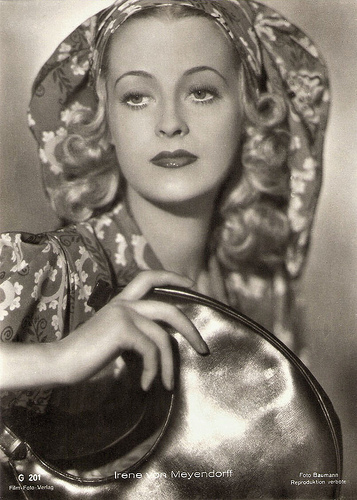 German postcard by Film-Foto-Verlag, no. G 201, 1941-1944. Photo: Foto Baumann.
German postcard by Film-Foto-Verlag, no. G 201, 1941-1944. Photo: Foto Baumann.
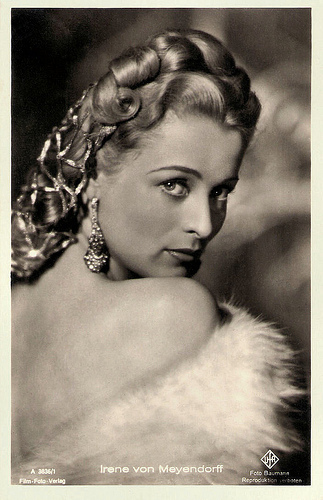
German postcard by Film-Foto-Verlag, no. A 3836/1, 1941-1944. Photo: Foto Baumann. / Ufa. From Tatiana.
The Horny Goat of Babelsberg
Irene von Meyendorff was born as Irene Isabella Margarethe Paulina Caecilia Freiin von Meyendorff in Reval, Russian Empire (now Tallinn, Estonia) in 1916. She was the eldest child of a German-Baltic aristocrat.
After the October Revolution, the family fled to Bremen in Germany. There Irene's mother Elisabeth left her conservative husband with the children to live an unconventional life in the theatre circles of Weimar/Thuringia.
In the early 1930s Irene went to Berlin to work as a cutter in the Ufa film studios of Babelsberg. The breathtaking beautiful, blond young woman was soon discovered for the screen.
Her debut was a mediocre swashbuckler film, Die letzten Vier von Santa Cruz/The Last Four of Santa Cruz (Werner Klingler, 1936), which unexpectedly made her a star.
She then appeared with Lída Baarová in Verräter/The Traitor (Karl Ritter, 1936), and with Hans Albers and Francoise Rosay in the circus film Fahrendes Volk/People Who Travel (Jacques Feyder, 1938).
Von Meijendorff starred opposite Erich Ponto in Schneider Wibbel/Tailor Wibbel ( Viktor de Kowa , 1939) based on a script by Helmut Käutner, and opposite Hans Moser in the comedy Einmal der liebe Herrgott sein/To Be God For Once (Hans H. Zerlett, 1942). She also starred in operetta films such as Frau Luna/Lady Luna ( Theo Lingen , 1943) with Lizzi Waldmüller .
Maybe her best part during this period was the noble Hamburg Patrician daughter Octavia in Veit Harlan 's Opfergang/The Great Sacrifice (1944) with Carl Raddatz and Kristina Söderbaum . She also appeared in Harlan’s propaganda film Kolberg/Burning Hearts (Veit Harlan, 1945) starring Söderbaum and Heinrich George .
This film was the pride and joy of the Nazi propaganda machine. It was filmed during the last year of the war. Lavish financial and material resources were expended to produce the film and it premiered just ahead of the advancing allied armies.
Von Meyendorff never was a sympathizer of the Nazi system though. Her first husband, Dr. Heinz Zahler, was a member of the Kreisau Circle, a group of religious motivated anti-Nazi-bourgeois. Her beauty attracted Josef Goebbels, minister of propaganda, who got a harsh rebuff by her ("You would degrade me - and you would degrade yourself"), according to her own recollections. Reportedly, Goebbels's nasty nick name ‘Bock von Babelsberg' (Horny Goat of Babelsberg) was Irene's creation.
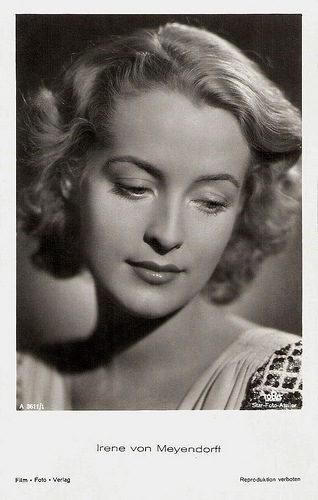
German postcard by Film-Foto-Verlag, no. A 3611/1, 1941-1944. Photo: Tobis /Star Foto Atelier.
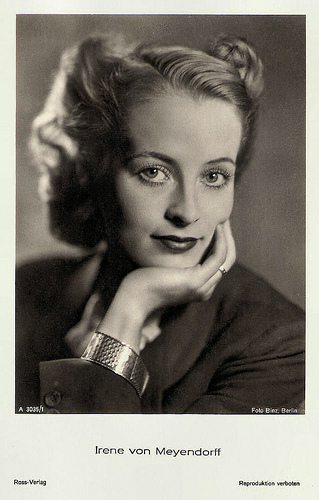
German postcard by Ross-Verlag, no. A 3035/1, 1941-1944. Photo: Binz, Berlin.
A Modern Adam and Eve
Between 1946 and 1949 some German films showed the will not to just simply go on like nothing happened but to search for new forms of entertainment in the light of the Second World War and the guilt of the German people.
Irene von Meyendorff starred in one of these films, Film ohne Titel/Film Without a Title (Rudolf Jugert, 1948) with Hans Söhnker and Hildegard Knef . Reviewer Herbert Schwaab writes at IMDb that the film is an “interesting reflection about the rights to be entertained: Which stories can be told, when all stories seem to have been finished? It shows the attempts of a film crew to shoot a film. They offer several versions of one simple love story in different film form (melodrama or German expressionism) until they come out with the right form (which is this film itself).”
That same year she was also seen in the bio The Mozart Story (Karl Hartl, Frank Wisbar, 1948) featuring Hans Holt . This was an Austrian film that was begun by Karl Hartl prior to World War II, but was shelved, unfinished, when the war began. After the war, the American rights to the film were purchased by Screen Guild. American-German director Frank Wisbar supervised the English dubbing, and even added some new scenes, with Wilton Graff as Mozart's great rival Antonio Salieri. The result was released as a new film, when it was actually at least 10 years old.
Hal Erickson at AllMovie comments: “Despite its patchwork construction, The Mozart Story weaves a cogent and credible (if not altogether accurate) version of Mozart's life and work.”
Another interesting film was Der Apfel ist Ab/The Original Sin (Helmut Käutner, 1948), a fascinating fantasy about a modern Adam and Eve.
The next year she played the lead role in the comedy Einmaleins der Ehe/1 x 1 of the Marriage (Rudolf Jugert, 1949) opposite Hans Söhnker and in 1950 she co-starred in Epilog: Das Geheimnis der Orplid/Epilogue (Helmut Käutner, 1950) a suspenseful drama about people on board of a boat.
In 1953 she starred in the crime film Gift im Zoo/Poison in the Zoo (1953, Hans Müller) with Carl Raddatz . She again worked with Helmut Käutner in the romance Bildnis einer Unbekannten/Portrait of an Unknown Woman (Helmut Käutner, 1954) starring Ruth Leuwerik and O.W. Fischer.
During the second half of the 1950s her roles became less frequent and her films less interesting. She focused more on her stage career and played in theatres in Stuttgart, Zürich, Frankfurt am Main and Hamburg.
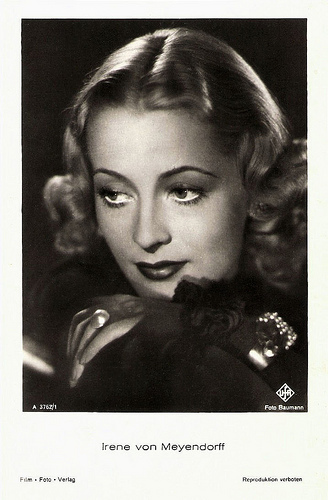
German postcard by Film-Foto-Verlag, no. A 3762/1, 1941-1944. Photo: Ufa / Foto Baumann.
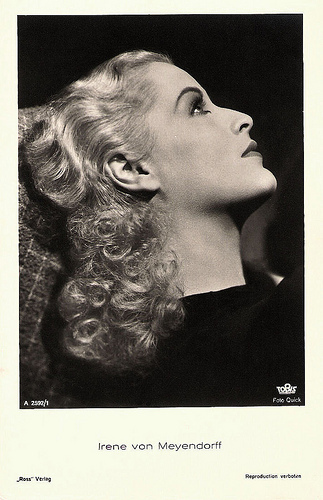
German postcard by Ross Verlag, no. A 2592, 1941-1944. Photo: Tobis / Quick.
Irina
In 1960 Irene von Meyendorff met British actor James Robertson Justice on the set of Die Botschafterin/The Ambassadress (Harald Braun, 1960). The couple fell passionately in love. She left her third husband, journalist Pit Severin, to follow Robertson Justice to England. (Her second husband had been film producer Joachim Matthes).
Incidentally she appeared in German films like Lange Beine - lange Finger/Long Legs, Long Fingers (Alfred Vohrer, 1966) starring Senta Berger .
She became a British citizen in 1967, and changed her name to Irina. She did small parts in international films with her husband such as the crime film Hell is empty (John Ainsworth, Bernard Knowles, 1967) starring Martine Carol in her last role, and the costume drama Mayerling (Terence Young, 1968) with Omar Sharif and Catherine Deneuve .
Her last film was the Italian production Il gesto/The Gesture (Marcello Grottesi, 1973) with Ilse Steppat and Willy Birgel .
A series of strokes gradually prevented James Robertson Justice working and led to his bankruptcy. Earning her living as a teacher at a local Language School, Irina nursed him until his death in 1975.
After 14 years of living together, they were finally married on his deathbed in hospital.
In 1990, she married his best friend and their neighbour, the millionaire and philanthropist Keith ‘Toby’ Bromley. She was a passionate gardener and excellent cook, her rose garden at Ashley Manor - the home she and Keith Bromley shared - was renowned locally as was her extensive hospitality.
Even at the age of 70 she sailed to the Artic and the Orinoco River. For her long and acclaimed work in the German cinema, she was awarded the Filmband in Gold in 1988.
In 2001, Irene von Meyendorf died in 2001 of natural causes in King's Somborne, Hampshire, UK, after a full, remarkable life. She had one son, Andreas Zahler, who died in 1985. She had two grandchildren, Rebecca, daughter of Andreas Zahler, and a son from his first marriage.
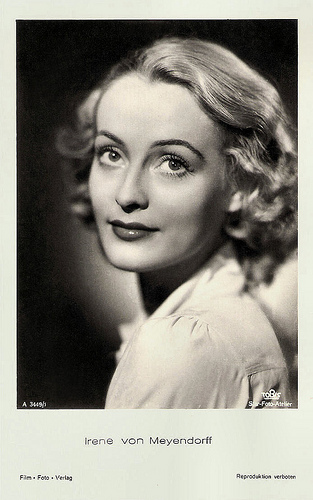
German postcard by Film-Foto-Verlag, no. A 3449/1, 1941-1944. Photo: Tobis / Star-Foto-Atelier.
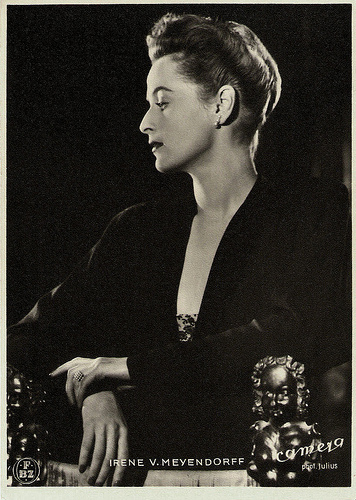
Vintage postcard in the Camera series by F.B.Z. Photo: Julius.

French postcard by EPC (Editions et Publications Cinematographoques), no. 250. Photo: Ufa / A.C.E.
Sources: Hal Erickson (AllMovie), Thomas Staedeli (Cyranos), (IMDb), Wikipedia (German) and .
 German postcard by Film-Foto-Verlag, no. G 201, 1941-1944. Photo: Foto Baumann.
German postcard by Film-Foto-Verlag, no. G 201, 1941-1944. Photo: Foto Baumann.
German postcard by Film-Foto-Verlag, no. A 3836/1, 1941-1944. Photo: Foto Baumann. / Ufa. From Tatiana.
The Horny Goat of Babelsberg
Irene von Meyendorff was born as Irene Isabella Margarethe Paulina Caecilia Freiin von Meyendorff in Reval, Russian Empire (now Tallinn, Estonia) in 1916. She was the eldest child of a German-Baltic aristocrat.
After the October Revolution, the family fled to Bremen in Germany. There Irene's mother Elisabeth left her conservative husband with the children to live an unconventional life in the theatre circles of Weimar/Thuringia.
In the early 1930s Irene went to Berlin to work as a cutter in the Ufa film studios of Babelsberg. The breathtaking beautiful, blond young woman was soon discovered for the screen.
Her debut was a mediocre swashbuckler film, Die letzten Vier von Santa Cruz/The Last Four of Santa Cruz (Werner Klingler, 1936), which unexpectedly made her a star.
She then appeared with Lída Baarová in Verräter/The Traitor (Karl Ritter, 1936), and with Hans Albers and Francoise Rosay in the circus film Fahrendes Volk/People Who Travel (Jacques Feyder, 1938).
Von Meijendorff starred opposite Erich Ponto in Schneider Wibbel/Tailor Wibbel ( Viktor de Kowa , 1939) based on a script by Helmut Käutner, and opposite Hans Moser in the comedy Einmal der liebe Herrgott sein/To Be God For Once (Hans H. Zerlett, 1942). She also starred in operetta films such as Frau Luna/Lady Luna ( Theo Lingen , 1943) with Lizzi Waldmüller .
Maybe her best part during this period was the noble Hamburg Patrician daughter Octavia in Veit Harlan 's Opfergang/The Great Sacrifice (1944) with Carl Raddatz and Kristina Söderbaum . She also appeared in Harlan’s propaganda film Kolberg/Burning Hearts (Veit Harlan, 1945) starring Söderbaum and Heinrich George .
This film was the pride and joy of the Nazi propaganda machine. It was filmed during the last year of the war. Lavish financial and material resources were expended to produce the film and it premiered just ahead of the advancing allied armies.
Von Meyendorff never was a sympathizer of the Nazi system though. Her first husband, Dr. Heinz Zahler, was a member of the Kreisau Circle, a group of religious motivated anti-Nazi-bourgeois. Her beauty attracted Josef Goebbels, minister of propaganda, who got a harsh rebuff by her ("You would degrade me - and you would degrade yourself"), according to her own recollections. Reportedly, Goebbels's nasty nick name ‘Bock von Babelsberg' (Horny Goat of Babelsberg) was Irene's creation.

German postcard by Film-Foto-Verlag, no. A 3611/1, 1941-1944. Photo: Tobis /Star Foto Atelier.

German postcard by Ross-Verlag, no. A 3035/1, 1941-1944. Photo: Binz, Berlin.
A Modern Adam and Eve
Between 1946 and 1949 some German films showed the will not to just simply go on like nothing happened but to search for new forms of entertainment in the light of the Second World War and the guilt of the German people.
Irene von Meyendorff starred in one of these films, Film ohne Titel/Film Without a Title (Rudolf Jugert, 1948) with Hans Söhnker and Hildegard Knef . Reviewer Herbert Schwaab writes at IMDb that the film is an “interesting reflection about the rights to be entertained: Which stories can be told, when all stories seem to have been finished? It shows the attempts of a film crew to shoot a film. They offer several versions of one simple love story in different film form (melodrama or German expressionism) until they come out with the right form (which is this film itself).”
That same year she was also seen in the bio The Mozart Story (Karl Hartl, Frank Wisbar, 1948) featuring Hans Holt . This was an Austrian film that was begun by Karl Hartl prior to World War II, but was shelved, unfinished, when the war began. After the war, the American rights to the film were purchased by Screen Guild. American-German director Frank Wisbar supervised the English dubbing, and even added some new scenes, with Wilton Graff as Mozart's great rival Antonio Salieri. The result was released as a new film, when it was actually at least 10 years old.
Hal Erickson at AllMovie comments: “Despite its patchwork construction, The Mozart Story weaves a cogent and credible (if not altogether accurate) version of Mozart's life and work.”
Another interesting film was Der Apfel ist Ab/The Original Sin (Helmut Käutner, 1948), a fascinating fantasy about a modern Adam and Eve.
The next year she played the lead role in the comedy Einmaleins der Ehe/1 x 1 of the Marriage (Rudolf Jugert, 1949) opposite Hans Söhnker and in 1950 she co-starred in Epilog: Das Geheimnis der Orplid/Epilogue (Helmut Käutner, 1950) a suspenseful drama about people on board of a boat.
In 1953 she starred in the crime film Gift im Zoo/Poison in the Zoo (1953, Hans Müller) with Carl Raddatz . She again worked with Helmut Käutner in the romance Bildnis einer Unbekannten/Portrait of an Unknown Woman (Helmut Käutner, 1954) starring Ruth Leuwerik and O.W. Fischer.
During the second half of the 1950s her roles became less frequent and her films less interesting. She focused more on her stage career and played in theatres in Stuttgart, Zürich, Frankfurt am Main and Hamburg.

German postcard by Film-Foto-Verlag, no. A 3762/1, 1941-1944. Photo: Ufa / Foto Baumann.

German postcard by Ross Verlag, no. A 2592, 1941-1944. Photo: Tobis / Quick.
Irina
In 1960 Irene von Meyendorff met British actor James Robertson Justice on the set of Die Botschafterin/The Ambassadress (Harald Braun, 1960). The couple fell passionately in love. She left her third husband, journalist Pit Severin, to follow Robertson Justice to England. (Her second husband had been film producer Joachim Matthes).
Incidentally she appeared in German films like Lange Beine - lange Finger/Long Legs, Long Fingers (Alfred Vohrer, 1966) starring Senta Berger .
She became a British citizen in 1967, and changed her name to Irina. She did small parts in international films with her husband such as the crime film Hell is empty (John Ainsworth, Bernard Knowles, 1967) starring Martine Carol in her last role, and the costume drama Mayerling (Terence Young, 1968) with Omar Sharif and Catherine Deneuve .
Her last film was the Italian production Il gesto/The Gesture (Marcello Grottesi, 1973) with Ilse Steppat and Willy Birgel .
A series of strokes gradually prevented James Robertson Justice working and led to his bankruptcy. Earning her living as a teacher at a local Language School, Irina nursed him until his death in 1975.
After 14 years of living together, they were finally married on his deathbed in hospital.
In 1990, she married his best friend and their neighbour, the millionaire and philanthropist Keith ‘Toby’ Bromley. She was a passionate gardener and excellent cook, her rose garden at Ashley Manor - the home she and Keith Bromley shared - was renowned locally as was her extensive hospitality.
Even at the age of 70 she sailed to the Artic and the Orinoco River. For her long and acclaimed work in the German cinema, she was awarded the Filmband in Gold in 1988.
In 2001, Irene von Meyendorf died in 2001 of natural causes in King's Somborne, Hampshire, UK, after a full, remarkable life. She had one son, Andreas Zahler, who died in 1985. She had two grandchildren, Rebecca, daughter of Andreas Zahler, and a son from his first marriage.

German postcard by Film-Foto-Verlag, no. A 3449/1, 1941-1944. Photo: Tobis / Star-Foto-Atelier.

Vintage postcard in the Camera series by F.B.Z. Photo: Julius.

French postcard by EPC (Editions et Publications Cinematographoques), no. 250. Photo: Ufa / A.C.E.
Sources: Hal Erickson (AllMovie), Thomas Staedeli (Cyranos), (IMDb), Wikipedia (German) and .
Published on July 13, 2014 23:00
July 12, 2014
Gustav 'Bubi' Scholz
Gustav ‘Bubi’ Scholz (1930-2000) was the most prominent German boxer of the post-war period. The southpaw was only a professional boxer, never an amateur. He celebrated his greatest triumphs in the late 1950s and early 1960s, and had some international successes. He also recorded Schlagers and appeared in films.
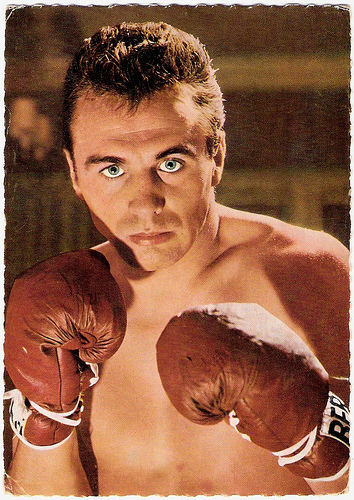
German postcard by Ufa (Universum-Film Aktiengesellschaft), Berlin-Tempelhof, no. CK 342. Retail price: 30 Pfg. Photo: Klaus Collignon / Ufa.
Southpaw
Gustav Wilhelm Hermann Scholz was born in Prenzlauer Berg, Berlin, in 1930. His father was a blacksmith, his mother was a homemaker.
‘Bubi’ earned his first money with selling newspapers. He studied to become a cook. From 1947 on he visited the boxing schools of Karl Schwarz and Bruno Müller, and from 1948 on the Olympia-boxschule where he met his future trainer Lado Taubeneck.
Scholz became both a good tactical and a good technical boxer, a southpaw. He never fought as an amateur and in 1948, he won his first professional match against Horst Eichler on points.
In 1951 he boxed for the first time for the national title. He won from Walter Schneider and became the German welterweight champion. He defended this title twice in 1952 – against Karl Oechsle and Leo Starosch. Later that year he voluntarily gave up this title for the middleweight championship.
In 1955 he was suddenly diagnosed with tuberculosis, and he was forbidden to box. Although he trained secretly he did not do any boxing matches until 1957.
With a K.O. victory in the third round against Peter ‘dä Aap (the Ape)' Müller, he became National champion middleweight.
From his victory in 1958 on the French champion Charles Humez till 1961, Bubi was the European champion middleweight and in 1964 he held the title in the heavyweight. In total he played 96 fights, of which he won 88, including 41 by knockout, he lost only twice (both defeats on points). In 1962 he had lost on points from the American World Champion middleweight, Harold Johnson.
The matches of the prominent boxer were visited by such celebrities as film star Curd Jürgens and politician Willy Brandt. Although he would never become a world champion, Scholz takes the rank of 45th as ‘Best Boxer of all time’ in the middleweight class in the independent, eternal world computer rankings of BoxRec.
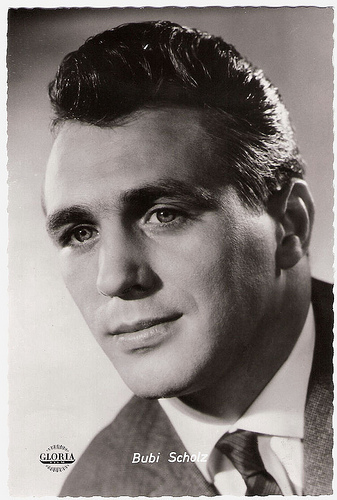
German postcard by Kolibri Filmverlag, Minden/Westf., no. 1193. Photo: CCC / Gloria-Film / Grimm. Publicity still for Marina (Paul Martin, 1960).
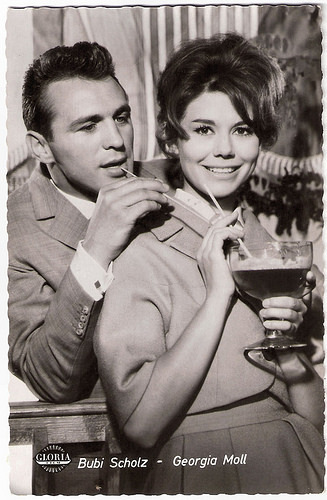
German postcard by Kolibri-Verlag G.m.b.H., Minden/Westf., no. 1212. Photo: Grimm / CCCfilm / Gloria. Publicity still for Marina (Paul Martin, 1960) with Giorgia Moll .
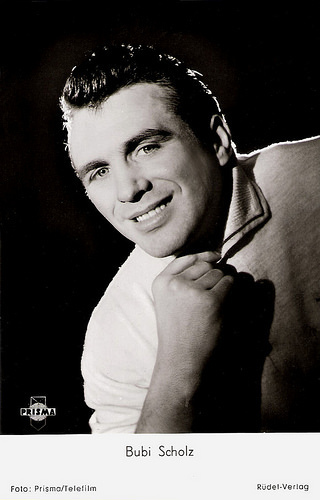
German postcard by Franz Josef Rüdel Filmpostkartenverlag, Hamburg-Bergedorf, no. 3313. Photo: Prisma / Telefilm. Publicity still for Schlagerparade 1961/Geh'n Sie nicht allein nach Hause - Die Schlagerparade 1961 (Franz Marischka, 1961).
Schlagers and Films
In 1965 Bubi Scholz finished his boxing career and started the advertising agency Zühlke & Scholz.
During his boxing career he had done several side-activities. He had recorded some Schlagers like Sie hat nur bluejeans (She only had blue jeans) and he also had performed in a few films.
In 1960 he had appeared at the side of Rocco Granata and the Italian actress Giorgia Moll in the Schlagerfilm Marina (Paul Martin, 1960).
Although a reviewer at IMDb compared his performance with “walking through after a K.O.”, Scholz appeared the following year in another Schlagerfilm, Schlagerparade 1961 (Ernst Marischka, 1961) with Renate Ewert and Chris Howland .
On TV he could be seen in the comedy Der Meisterboxer/The Box Champion (Günter Fiedler, Willy Millowitsch, 1960). Later, he appeared with the other legendary boxing champion, Max Schmeling, as two policemen in the comedy Glückspilze/Lucky Devils (Thomas Engel, 1971) with Heli Finkenzeller and Christian Wolff .
Now his active boxing career was over, Scholz became depressed and was known for his binge-drinking. He reached the low point in 1984, when he shot his wife, Helga Scholz-Druck, with whom he had been married since 1955. He was arrested the following day, and was sentenced to an imprisonment of three years for manslaughter.
After his period in jail, he appeared in two more films. He first appeared as a boxing coach in the short drama Chicago 6 x 6 (Clemens Füsers, 1989).
His last film was Mord aus Liebe/Murder out of Love (Georg Stefan Troller, 1993) with actress Ingrid von Bergen, who herself had spent nearly 5 years in prison for manslaughter.
In 1993, the 63-year-old Scholz married the 35-year-old Sabine Arndt. In the late 1990s he suffered several strokes and was diagnosed with Alzheimer’s disease.
His life was filmed for the TV film Die Bubi Scholz Story/The Bubi Scholz Story (Roland Suso Richter, 1999). Young Bubi was interpreted by Benno Furmann, while Götz George played the older Scholz.
Gustav ‘Bubi’ Scholz himself could not attend the premiere because of his poor health at that time. He died in 2000 in an elderly home in Berlin.
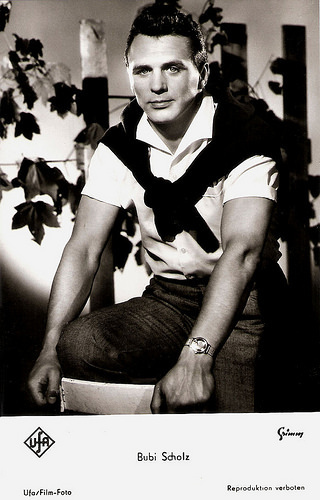
German postcard by Ufa, Berlin-Tempelhoff, no. FK 4877. Photo: Ufa / Grimm.
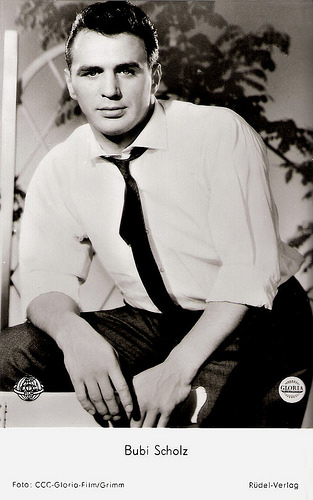
German postcard by Franz Josef Rüdel Filmpostkartenverlag, Hamburg-Bergedorf, no. 3064. Photo: CCC / Gloria-Film / Grimm. Publicity still for Marina (Paul Martin, 1960).
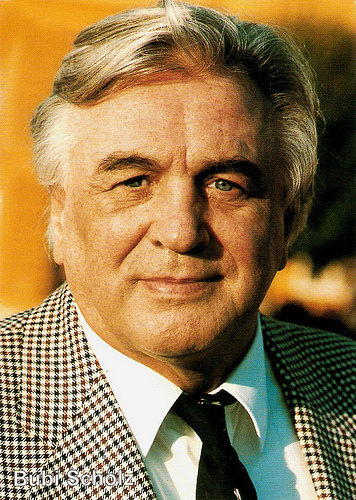
German postcard by Franz Josef Rüdel, Filmpostkartenverlag, Hamburg. Photo: Peter Rondholz.
Bubi Scholz sings Sie hat nur blue jeans. Source: Blizzardjens (YouTube).
Sources: Oliver Marschalek (Neue deutsche Biographie) (German), Michael Mielke (Weltonline) (German), BoxRec, Wikipedia (German) and .

German postcard by Ufa (Universum-Film Aktiengesellschaft), Berlin-Tempelhof, no. CK 342. Retail price: 30 Pfg. Photo: Klaus Collignon / Ufa.
Southpaw
Gustav Wilhelm Hermann Scholz was born in Prenzlauer Berg, Berlin, in 1930. His father was a blacksmith, his mother was a homemaker.
‘Bubi’ earned his first money with selling newspapers. He studied to become a cook. From 1947 on he visited the boxing schools of Karl Schwarz and Bruno Müller, and from 1948 on the Olympia-boxschule where he met his future trainer Lado Taubeneck.
Scholz became both a good tactical and a good technical boxer, a southpaw. He never fought as an amateur and in 1948, he won his first professional match against Horst Eichler on points.
In 1951 he boxed for the first time for the national title. He won from Walter Schneider and became the German welterweight champion. He defended this title twice in 1952 – against Karl Oechsle and Leo Starosch. Later that year he voluntarily gave up this title for the middleweight championship.
In 1955 he was suddenly diagnosed with tuberculosis, and he was forbidden to box. Although he trained secretly he did not do any boxing matches until 1957.
With a K.O. victory in the third round against Peter ‘dä Aap (the Ape)' Müller, he became National champion middleweight.
From his victory in 1958 on the French champion Charles Humez till 1961, Bubi was the European champion middleweight and in 1964 he held the title in the heavyweight. In total he played 96 fights, of which he won 88, including 41 by knockout, he lost only twice (both defeats on points). In 1962 he had lost on points from the American World Champion middleweight, Harold Johnson.
The matches of the prominent boxer were visited by such celebrities as film star Curd Jürgens and politician Willy Brandt. Although he would never become a world champion, Scholz takes the rank of 45th as ‘Best Boxer of all time’ in the middleweight class in the independent, eternal world computer rankings of BoxRec.

German postcard by Kolibri Filmverlag, Minden/Westf., no. 1193. Photo: CCC / Gloria-Film / Grimm. Publicity still for Marina (Paul Martin, 1960).

German postcard by Kolibri-Verlag G.m.b.H., Minden/Westf., no. 1212. Photo: Grimm / CCCfilm / Gloria. Publicity still for Marina (Paul Martin, 1960) with Giorgia Moll .

German postcard by Franz Josef Rüdel Filmpostkartenverlag, Hamburg-Bergedorf, no. 3313. Photo: Prisma / Telefilm. Publicity still for Schlagerparade 1961/Geh'n Sie nicht allein nach Hause - Die Schlagerparade 1961 (Franz Marischka, 1961).
Schlagers and Films
In 1965 Bubi Scholz finished his boxing career and started the advertising agency Zühlke & Scholz.
During his boxing career he had done several side-activities. He had recorded some Schlagers like Sie hat nur bluejeans (She only had blue jeans) and he also had performed in a few films.
In 1960 he had appeared at the side of Rocco Granata and the Italian actress Giorgia Moll in the Schlagerfilm Marina (Paul Martin, 1960).
Although a reviewer at IMDb compared his performance with “walking through after a K.O.”, Scholz appeared the following year in another Schlagerfilm, Schlagerparade 1961 (Ernst Marischka, 1961) with Renate Ewert and Chris Howland .
On TV he could be seen in the comedy Der Meisterboxer/The Box Champion (Günter Fiedler, Willy Millowitsch, 1960). Later, he appeared with the other legendary boxing champion, Max Schmeling, as two policemen in the comedy Glückspilze/Lucky Devils (Thomas Engel, 1971) with Heli Finkenzeller and Christian Wolff .
Now his active boxing career was over, Scholz became depressed and was known for his binge-drinking. He reached the low point in 1984, when he shot his wife, Helga Scholz-Druck, with whom he had been married since 1955. He was arrested the following day, and was sentenced to an imprisonment of three years for manslaughter.
After his period in jail, he appeared in two more films. He first appeared as a boxing coach in the short drama Chicago 6 x 6 (Clemens Füsers, 1989).
His last film was Mord aus Liebe/Murder out of Love (Georg Stefan Troller, 1993) with actress Ingrid von Bergen, who herself had spent nearly 5 years in prison for manslaughter.
In 1993, the 63-year-old Scholz married the 35-year-old Sabine Arndt. In the late 1990s he suffered several strokes and was diagnosed with Alzheimer’s disease.
His life was filmed for the TV film Die Bubi Scholz Story/The Bubi Scholz Story (Roland Suso Richter, 1999). Young Bubi was interpreted by Benno Furmann, while Götz George played the older Scholz.
Gustav ‘Bubi’ Scholz himself could not attend the premiere because of his poor health at that time. He died in 2000 in an elderly home in Berlin.

German postcard by Ufa, Berlin-Tempelhoff, no. FK 4877. Photo: Ufa / Grimm.

German postcard by Franz Josef Rüdel Filmpostkartenverlag, Hamburg-Bergedorf, no. 3064. Photo: CCC / Gloria-Film / Grimm. Publicity still for Marina (Paul Martin, 1960).

German postcard by Franz Josef Rüdel, Filmpostkartenverlag, Hamburg. Photo: Peter Rondholz.
Bubi Scholz sings Sie hat nur blue jeans. Source: Blizzardjens (YouTube).
Sources: Oliver Marschalek (Neue deutsche Biographie) (German), Michael Mielke (Weltonline) (German), BoxRec, Wikipedia (German) and .
Published on July 12, 2014 23:00
July 11, 2014
Louise Carletti
Beautiful, photogenic actress Louis Carletti (1922-2002) was the young and sweet star of the French cinema of the late 1930s and 1940s.
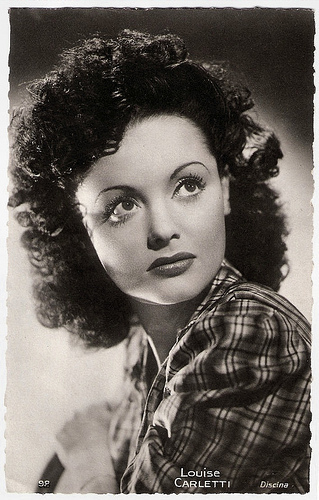
French postcard by Editions E.C., Paris, no. 92. Photo: Discina.
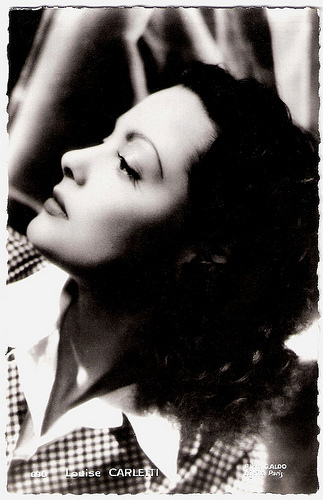
French postcard by Collection Chantal, no. 838. Photo: G. Aldo / Discina, Paris.
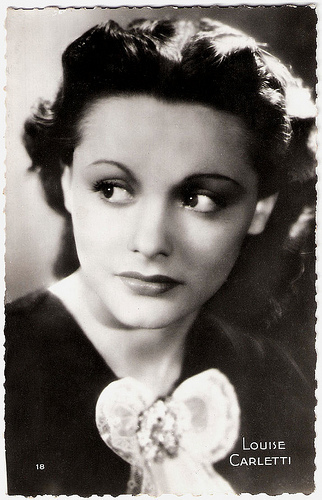
French postcard by Editions P.I., Paris, no. 18.
A Family of Trapeze Artists
Louise Carletti was born Luisa Armida Paola Carboni in a family of trapeze artists in Marseille, France, in 1922.
She had her first performance as an acrobat at the age of seven at the music hall of Marseille. Her sister Victoria would later become known as the actress Carlettina.
Louise was discovered by the famous film director Jacques Feyder when she did a dance act with Victoria. At 15, Louise made her first film appearance in the circus film Les Gens du voyage/People Who Travel (Jacques Feyder, 1938), starring Françoise Rosay .
Her breakthrough came two years later with the successful films L' Enfer des anges/Angels of the Underground (1940, Christian-Jaque) with Mouloudji , and Nous, les gosses/Portrait of Innocence (1941, Louis Daquin) with Gilbert Gil.
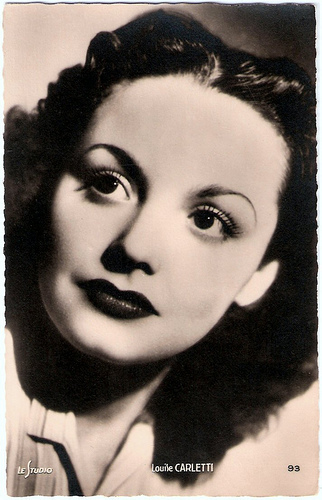
French postcard by Editions O.P., Paris, no. 93. Photo: Le Studio.
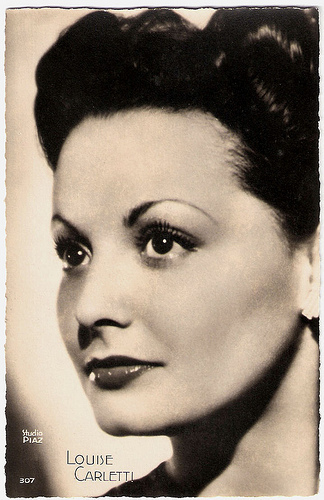
French postcard by Editions O.P., Paris, no. 307. Photo: Studio Piaz.
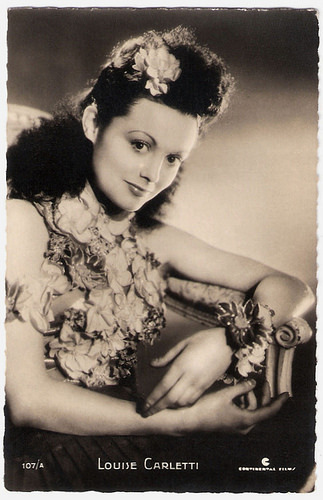
French postcard by Editions Continental, no. 107/A. Photo: Continental Films.
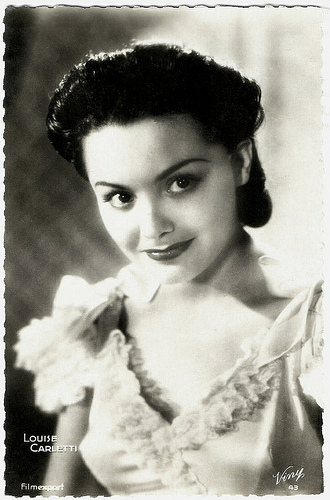
French postcard by Viny, no. 43. Photo: Filmexport.
Raoul André
The next years Louise Carletti became a busy film star, and she proved to be equally good in comic as in dramatic parts.
In 1942, when she was 20, she played opposite the legendary actor Henri Garat in Annette et la dame blonde/Annette and the Blonde Woman (Jean Dréville, 1942).
Other better known productions of those years are Macao, l'enfer du jeu/Gambling Hell (Jean Delannoy, 1942) with the legendary silent film star Sessue Hayakawa, Patricia (Paul Mesnier, 1942), Des jeunes filles dans la nuit/Young Girls at Night (1943, René Le Hénaff), L'ennemi sans visage/The Enemy Without a Face (1946, Robert-Paul Dagan), and Fausse identité/False Identity (André Chotin, 1947) with Raymond Bussières.
In 1946, she appeared in Le Village de la colère/The Village of Wrath, her first film directed by Raoul André.
In 1955 they married, and their daughter, Ariane Carletti, would also become an actress.
In the 1950s Louise mainly worked with her husband in films like Une fille à croquer/Good Enough to Eat (1951) opposite Gaby Morlay , Les pépées au service secret/The Pépées in secret service (1956), and La planque/The Hideout (1961) with Mouloudji.
Her last film was the adventure Mission spéciale à Caracas/Mission to Caracas (Raoul André, 1965). That same year she retired to occupy herself with her family.
Louise Carletti died in 2002 in Boulogne-Billancourt, France, at age 80.
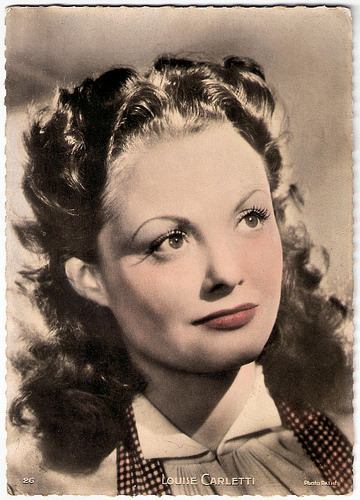
French postcard by Editions P.I., Paris, no. 26. Photo: Pathé.
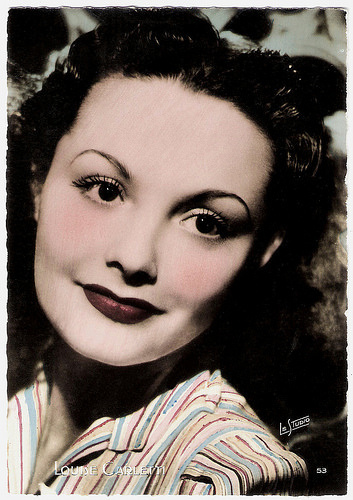
French postcard by Editions O.P., Paris, no. 53. Photo: Le Studio.
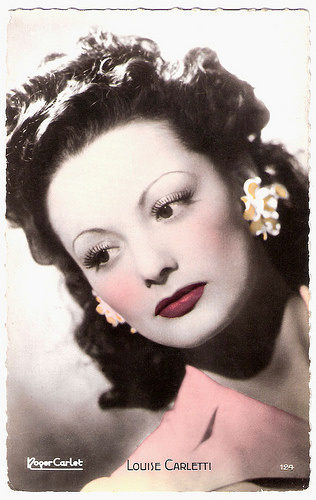
French postcard by Editions P.I., Paris, no. 124. Photo: Roger Carlet.
Sources: Thomas Staedeli (Cyranos), Wikipedia (French), Allocine (French), and .

French postcard by Editions E.C., Paris, no. 92. Photo: Discina.

French postcard by Collection Chantal, no. 838. Photo: G. Aldo / Discina, Paris.

French postcard by Editions P.I., Paris, no. 18.
A Family of Trapeze Artists
Louise Carletti was born Luisa Armida Paola Carboni in a family of trapeze artists in Marseille, France, in 1922.
She had her first performance as an acrobat at the age of seven at the music hall of Marseille. Her sister Victoria would later become known as the actress Carlettina.
Louise was discovered by the famous film director Jacques Feyder when she did a dance act with Victoria. At 15, Louise made her first film appearance in the circus film Les Gens du voyage/People Who Travel (Jacques Feyder, 1938), starring Françoise Rosay .
Her breakthrough came two years later with the successful films L' Enfer des anges/Angels of the Underground (1940, Christian-Jaque) with Mouloudji , and Nous, les gosses/Portrait of Innocence (1941, Louis Daquin) with Gilbert Gil.

French postcard by Editions O.P., Paris, no. 93. Photo: Le Studio.

French postcard by Editions O.P., Paris, no. 307. Photo: Studio Piaz.

French postcard by Editions Continental, no. 107/A. Photo: Continental Films.

French postcard by Viny, no. 43. Photo: Filmexport.
Raoul André
The next years Louise Carletti became a busy film star, and she proved to be equally good in comic as in dramatic parts.
In 1942, when she was 20, she played opposite the legendary actor Henri Garat in Annette et la dame blonde/Annette and the Blonde Woman (Jean Dréville, 1942).
Other better known productions of those years are Macao, l'enfer du jeu/Gambling Hell (Jean Delannoy, 1942) with the legendary silent film star Sessue Hayakawa, Patricia (Paul Mesnier, 1942), Des jeunes filles dans la nuit/Young Girls at Night (1943, René Le Hénaff), L'ennemi sans visage/The Enemy Without a Face (1946, Robert-Paul Dagan), and Fausse identité/False Identity (André Chotin, 1947) with Raymond Bussières.
In 1946, she appeared in Le Village de la colère/The Village of Wrath, her first film directed by Raoul André.
In 1955 they married, and their daughter, Ariane Carletti, would also become an actress.
In the 1950s Louise mainly worked with her husband in films like Une fille à croquer/Good Enough to Eat (1951) opposite Gaby Morlay , Les pépées au service secret/The Pépées in secret service (1956), and La planque/The Hideout (1961) with Mouloudji.
Her last film was the adventure Mission spéciale à Caracas/Mission to Caracas (Raoul André, 1965). That same year she retired to occupy herself with her family.
Louise Carletti died in 2002 in Boulogne-Billancourt, France, at age 80.

French postcard by Editions P.I., Paris, no. 26. Photo: Pathé.

French postcard by Editions O.P., Paris, no. 53. Photo: Le Studio.

French postcard by Editions P.I., Paris, no. 124. Photo: Roger Carlet.
Sources: Thomas Staedeli (Cyranos), Wikipedia (French), Allocine (French), and .
Published on July 11, 2014 23:00
July 10, 2014
Johanna Matz
Austrian actress Johanna Matz (1932) made a blitz career in the 1950s as the natural ‘Wiener Mädel’ (the Viennese Gal). She acted in more than forty films and TV films, but she considered herself primarily a theatre actress.
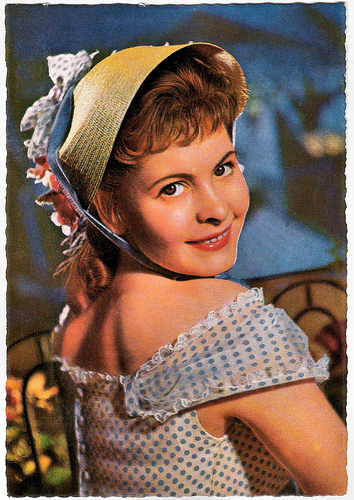
German postcard by WS-Druck, Wanne-Eickel, no. F 40. Photo: Niczky.
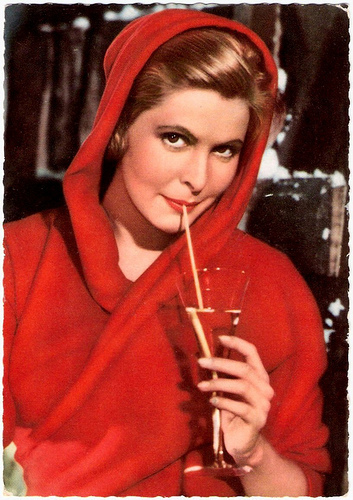
German postcard by Ufa, Berlin, no. CK-118. Photo: Arthur Grimm / Ufa.
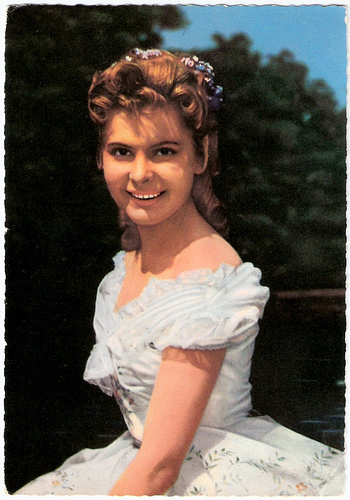
German postcard by ISV, no. C 5. Photo: Cosmos-Neusser / Gloria / Appelt.
Clean and Spontaneous
Johanna Maria Emilie Dorothea Matz was born in Vienna in 1932. When 'Hannerl' was just four years old, she began taking ballet lessons at the Vienna Academy.
Later she had a stage training at the Max-Reinhardt-Seminar. At the final presentation in 1950 she was discovered by Berthold Viertel and engaged for the prestigious Burgtheater, where she would be a contract player untill 1993.
In 1951 she made her film debut in Asphalt (Harald Röbbeling, 1951) as a girl who becomes a prostitute.
In the comedies Der alte Sünder/The Old Sinner (Franz Antel, 1951) and Zwei in einem Auto/Two in a car (Ernst Marischka, 1951) she played her typical character, the clean and spontaneous girl from Vienna.
She became a film star with her sweet and charming role in the operetta Die Försterchristl/The Forester's Daughter (Arthur Maria Rabenalt, 1952) opposite Will Quadflieg .
Director Otto Preminger then invited her to Hollywood where she played the lead in the German language version of the controversial comedy The Moon is Blue (Otto Preminger, 1953). In Die Jungfrau auf dem Dach (Otto Preminger, 1953) she starred with Hardy Krüger and Johannes Heesters . Krüger and Matz also played brief roles as tourists at the Empire State Building sequence in the English language version while the stars of that version, William Holden and Maggie McNamara, played the same roles in the German version.
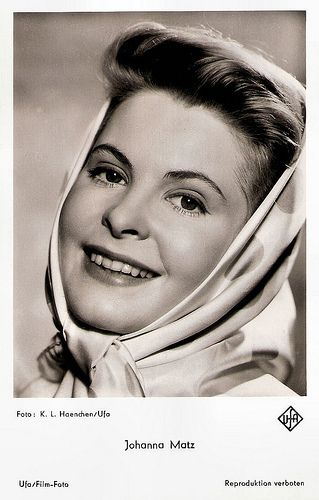
German postcard by Ufa, Berlin-Tempelhof, no. FK 4157. Photo: K.L. Haenchen / Ufa. Publicity still for Man müßte nochmal zwanzig sein/One would have to be twenty again (Hans Quest, 1958).
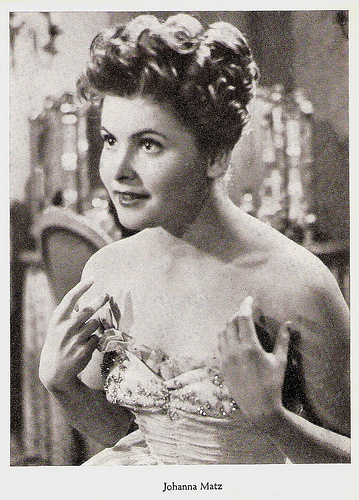
German collector's card.
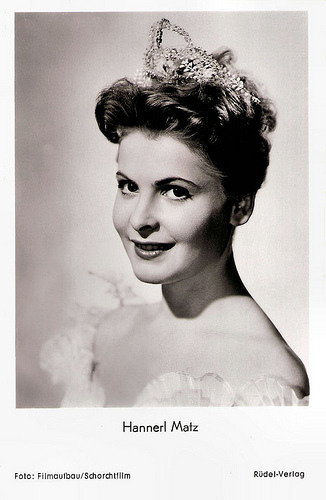
German postcard by Rüdel Verlag, Hamburg-Bergedorf, no. 1242. Photo: Filmaufbau / Schorchtfilm. Publicity still for Ingrid - die Geschichte eines Fotomodells/Ingrid, the Story of a Model (Géza von Radványi, 1955).
Operettas and Classic Dramas
In 1954 Johanna Matz also made Mannequins für Rio (Kurt Neumann, 1954), a melodrama about white slavery co-starring Scott Brady and Raymond Burr. This film was also made in an English language with the same stars as They Were So Young.
That year she returned to the stage, because she considered herself primarily a theatre actress. She became a popular performer of the heroins of the classic dramas by Arthur Schnitzler, Gotthold Ephraim Lessing and Johann Wolfgang von Goethe, but also as the star in operettas.
Occasionally she played in such films like Mozart/The Life and Loves of Mozart (Karl Hartl, 1955) opposite Oskar Werner, Regine (Harald Braun, 1956) with Horst Buchholz , Frau Warrens Gewerbe/Mrs. Warren's Profession (Ákos Ráthonyi, 1960) with Lilli Palmer , Die Glücklichen Jahre der Thorwalds/The Happy Years of the Thorwalds (John Olden, Wolfgang Staudte, 1962) with Elisabeth Bergner , and the Heimatfilm Ruf der Wälder/Call of the Forests (Franz Antel, 1965) with Mario Girotti (Terence Hill).
Since the end of the 1960s she was mainly seen in Austrian TV productions.
In the cinema she was seen in the Heinz Rühmann vehicle Der Kapitän/The Captain (Kurt Hoffmann, 1971) and the Eric Malpass adaptation Als Mutter streikte/When Mother Went on Strike (Eberhard Schröder, 1975) with Peter Hall.
One of her last screen appearances was as herself in Bellaria - So lange wir leben!/Bellaria: As Long as We Live! (Douglas Wolfsperger, 2002), a beautiful documentary about the traditional Viennese cinema Bellaria, which is specialized in German cinema from the 1920s, 1930s and 1940s, and its regular customers.
Johnna Matz was married twice. First to actor Karl Hackenberg (1956-2002) with whom she had a child. After his death, she married to Harry von Wutzler. The couple lives retired in Unterachen am Attersee in Austria.
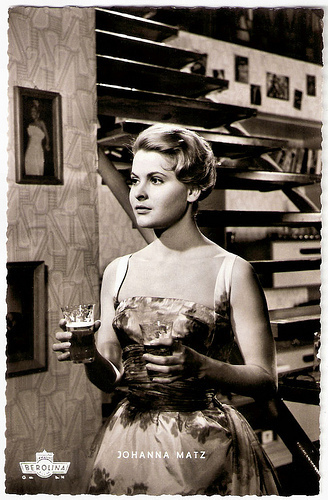
German postcard by Kunst und Bild, Berlin-Charlottenburg, no. S 773. Photo: Wesel / Berolina. Publicity still for Es wird alles wieder gut/Everything Is Going to Be All Right (Géza von Bolváry, 1957).
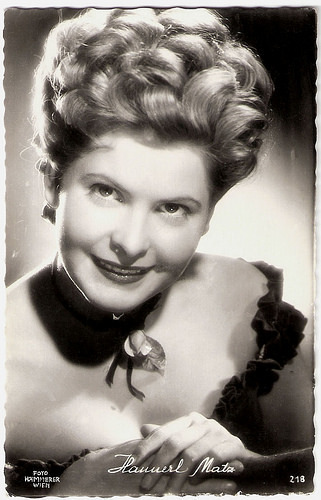
Austrian postcard by Verlag Hubmann (HDH), Wien, no. 218. Photo: Hämmerer, Wien.
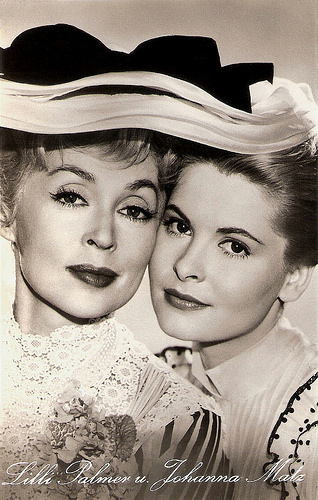
East-German postcard by Progress, no. 1306, 1960. Photo: publicity still for Frau Warrens Gewerbe/Mrs. Warren's Profession (Ákos Ráthonyi, 1960).
Trailer for Mannequins für Rio/They Were So Young (1954) with Raymond Burr, Scott Brady and Ingrid Stenn. Source: Rudi Polt (YouTube).
Johanna Matz sings Das Gibt's Nur Einmal in the Der Kongress Tanzt/Congress Dances (Franz Antel, 1956), a remake of the classic film operetta of 1931 starring Lilian Harvey .
Sources: (IMDb), Stephanie D'heil (Steffi-line) (German), Wikipedia and .

German postcard by WS-Druck, Wanne-Eickel, no. F 40. Photo: Niczky.

German postcard by Ufa, Berlin, no. CK-118. Photo: Arthur Grimm / Ufa.

German postcard by ISV, no. C 5. Photo: Cosmos-Neusser / Gloria / Appelt.
Clean and Spontaneous
Johanna Maria Emilie Dorothea Matz was born in Vienna in 1932. When 'Hannerl' was just four years old, she began taking ballet lessons at the Vienna Academy.
Later she had a stage training at the Max-Reinhardt-Seminar. At the final presentation in 1950 she was discovered by Berthold Viertel and engaged for the prestigious Burgtheater, where she would be a contract player untill 1993.
In 1951 she made her film debut in Asphalt (Harald Röbbeling, 1951) as a girl who becomes a prostitute.
In the comedies Der alte Sünder/The Old Sinner (Franz Antel, 1951) and Zwei in einem Auto/Two in a car (Ernst Marischka, 1951) she played her typical character, the clean and spontaneous girl from Vienna.
She became a film star with her sweet and charming role in the operetta Die Försterchristl/The Forester's Daughter (Arthur Maria Rabenalt, 1952) opposite Will Quadflieg .
Director Otto Preminger then invited her to Hollywood where she played the lead in the German language version of the controversial comedy The Moon is Blue (Otto Preminger, 1953). In Die Jungfrau auf dem Dach (Otto Preminger, 1953) she starred with Hardy Krüger and Johannes Heesters . Krüger and Matz also played brief roles as tourists at the Empire State Building sequence in the English language version while the stars of that version, William Holden and Maggie McNamara, played the same roles in the German version.

German postcard by Ufa, Berlin-Tempelhof, no. FK 4157. Photo: K.L. Haenchen / Ufa. Publicity still for Man müßte nochmal zwanzig sein/One would have to be twenty again (Hans Quest, 1958).

German collector's card.

German postcard by Rüdel Verlag, Hamburg-Bergedorf, no. 1242. Photo: Filmaufbau / Schorchtfilm. Publicity still for Ingrid - die Geschichte eines Fotomodells/Ingrid, the Story of a Model (Géza von Radványi, 1955).
Operettas and Classic Dramas
In 1954 Johanna Matz also made Mannequins für Rio (Kurt Neumann, 1954), a melodrama about white slavery co-starring Scott Brady and Raymond Burr. This film was also made in an English language with the same stars as They Were So Young.
That year she returned to the stage, because she considered herself primarily a theatre actress. She became a popular performer of the heroins of the classic dramas by Arthur Schnitzler, Gotthold Ephraim Lessing and Johann Wolfgang von Goethe, but also as the star in operettas.
Occasionally she played in such films like Mozart/The Life and Loves of Mozart (Karl Hartl, 1955) opposite Oskar Werner, Regine (Harald Braun, 1956) with Horst Buchholz , Frau Warrens Gewerbe/Mrs. Warren's Profession (Ákos Ráthonyi, 1960) with Lilli Palmer , Die Glücklichen Jahre der Thorwalds/The Happy Years of the Thorwalds (John Olden, Wolfgang Staudte, 1962) with Elisabeth Bergner , and the Heimatfilm Ruf der Wälder/Call of the Forests (Franz Antel, 1965) with Mario Girotti (Terence Hill).
Since the end of the 1960s she was mainly seen in Austrian TV productions.
In the cinema she was seen in the Heinz Rühmann vehicle Der Kapitän/The Captain (Kurt Hoffmann, 1971) and the Eric Malpass adaptation Als Mutter streikte/When Mother Went on Strike (Eberhard Schröder, 1975) with Peter Hall.
One of her last screen appearances was as herself in Bellaria - So lange wir leben!/Bellaria: As Long as We Live! (Douglas Wolfsperger, 2002), a beautiful documentary about the traditional Viennese cinema Bellaria, which is specialized in German cinema from the 1920s, 1930s and 1940s, and its regular customers.
Johnna Matz was married twice. First to actor Karl Hackenberg (1956-2002) with whom she had a child. After his death, she married to Harry von Wutzler. The couple lives retired in Unterachen am Attersee in Austria.

German postcard by Kunst und Bild, Berlin-Charlottenburg, no. S 773. Photo: Wesel / Berolina. Publicity still for Es wird alles wieder gut/Everything Is Going to Be All Right (Géza von Bolváry, 1957).

Austrian postcard by Verlag Hubmann (HDH), Wien, no. 218. Photo: Hämmerer, Wien.

East-German postcard by Progress, no. 1306, 1960. Photo: publicity still for Frau Warrens Gewerbe/Mrs. Warren's Profession (Ákos Ráthonyi, 1960).
Trailer for Mannequins für Rio/They Were So Young (1954) with Raymond Burr, Scott Brady and Ingrid Stenn. Source: Rudi Polt (YouTube).
Johanna Matz sings Das Gibt's Nur Einmal in the Der Kongress Tanzt/Congress Dances (Franz Antel, 1956), a remake of the classic film operetta of 1931 starring Lilian Harvey .
Sources: (IMDb), Stephanie D'heil (Steffi-line) (German), Wikipedia and .
Published on July 10, 2014 23:00
Jean Daragon
Jean Daragon (1870-1923) was a French stage and screen actor, who was married to actress Marguerite Moreno.
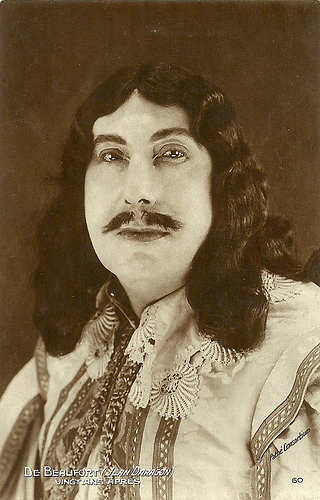
French postcard by Editions Cinémagazine, no. 60. Photo: Pathé Consortium Cinema. Publicity still of Jean Daragon as De Beaufort in the Alexandre Dumas adaptation Vingt ans après/The Return of the Musketeers (Henri Diamant-Berger, 1922).
The Four Horsemen of the Apocalypse
Jean Baptiste Emile Daragon was born in Clermont-Ferrand at the French Auvergne in 1870.
From c. 1900 he became a well-known stage actor, playing e.g. in Les aventures du capitaine Corcoran/The adventures of Captain Corcoran (1902) and L'auberge des Adrets/The Inn of the Adrets (1903) at Théâtre du Châtelet.
In 1908 he married actress Marguerite Moreno and followed her to Buenos Aires.
They returned to France when war was imminent. While Moreno worked in a hospital, Daragon was obese and suffered from emphysema, so he was exempted from military service during the First World War.
When war broke out, all theaters were closed so Daragon and Moreno’s income was drastically reduced. With Moreno and many other Parisian stage actors he acted in Henri Diamant-Berger’s Paris pendant la guerre/Paris during the war (1916), a silent film which still exists.
Together with Moreno and Claude Mérelle , Daragon also acted in the Gaumont production Debout les morts!/Standing dead! (1916) directed by Henri Pouctal, Léonce Perret and André Heuzé, and scripted by Henri Diamant-Berger.
Debout les morts! was based on Vicente Blasco Ibanez’ The Four Horsemen of the Apocalypse, which would be adapted for film again by Rex Ingram in 1921, starring Rudolph Valentino and Alice Terry.
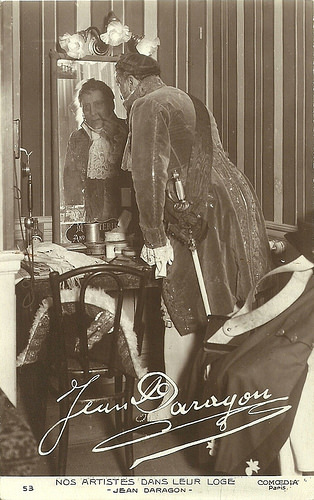
French postcard by Comoedia in the series Nos artistes dans leur loge, no. 53. Photo: Comoedia, Paris.
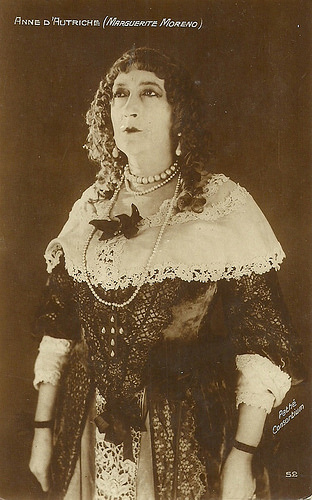
Marguerite Moreno in Vingt ans après. French postcard by Editions Cinémagazine, no. 52. Photo: Pathé Consortium Cinema. Publicity still of Moreno as Anne d'Autriche in Vingt ans après/The Return of the Musketeers (Henri Diamant-Berger, 1922).
The Return of the Musketeers
After the First World War, Jean Daragon acted in stage plays like Aux jardins de Murcie/In the gardens of Murcia (Théâtre Antoine, 1919, dir. Firmin Gémier), Le courrier de Lyon/The Courier of Lyon (Théâtre de la Porte Saint-Martin, 1920), and Sapho (Théâtre de la Porte Saint-Martin, 1921), the latter two with Moreno.
In the cinema he acted in Musidora’s film Pour Don Carlos/Don Carlos (Jacques Lasseyne, Musidora, 1920), based on Pierre Benoit’s 1920 novel.
In 1922 he played the part of the Duc de Beaufort in Henri Diamant-Berger’s sequel to his Les Trois Mousquetaires: Vingt ans après/The Return of the Musketeers (1922).
His wife Marguerite Moreno played Anne of Austria in the same film.
Daragon’s last film was Le doute/Doubt (Gaston Roudès, 1923), starring Rachel Devirys, Victor Francen and Jacques de Féraudy.
Jean Daragon died in 1923, in Paris.
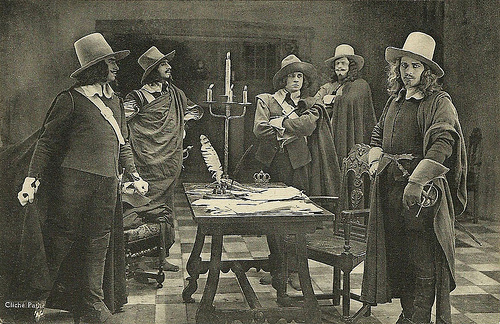
French postcard. Photo: Pathé. Publicity still for Vingt ans après/The Return of the Musketeers (Henri Diamant-Berger, 1922). Collection: Didier Hanson. The four musketeers were played by Jean Yonnel (D'Artagnan), Henri Rollan (Athos), Pierre de Guingand (Aramis) and Charles Martinelli (Porthos).
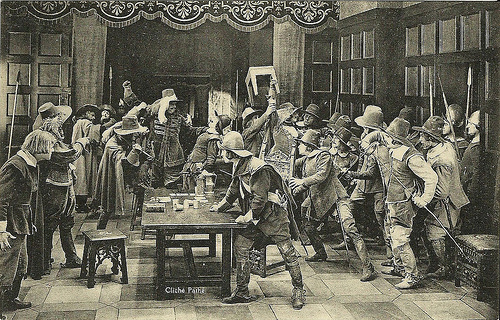
French postcard. Photo: Pathé. Publicity still for Vingt ans après/The Return of the Musketeers (Henri Diamant-Berger, 1922). Collection: Didier Hanson.
Sources: Judith Thurman (Secrets of the Flesh: A Life of Colette) and
Paris pendant la guerre exists as a bonus on the Flicker Alley 2-disc DVD of J’accuse.

French postcard by Editions Cinémagazine, no. 60. Photo: Pathé Consortium Cinema. Publicity still of Jean Daragon as De Beaufort in the Alexandre Dumas adaptation Vingt ans après/The Return of the Musketeers (Henri Diamant-Berger, 1922).
The Four Horsemen of the Apocalypse
Jean Baptiste Emile Daragon was born in Clermont-Ferrand at the French Auvergne in 1870.
From c. 1900 he became a well-known stage actor, playing e.g. in Les aventures du capitaine Corcoran/The adventures of Captain Corcoran (1902) and L'auberge des Adrets/The Inn of the Adrets (1903) at Théâtre du Châtelet.
In 1908 he married actress Marguerite Moreno and followed her to Buenos Aires.
They returned to France when war was imminent. While Moreno worked in a hospital, Daragon was obese and suffered from emphysema, so he was exempted from military service during the First World War.
When war broke out, all theaters were closed so Daragon and Moreno’s income was drastically reduced. With Moreno and many other Parisian stage actors he acted in Henri Diamant-Berger’s Paris pendant la guerre/Paris during the war (1916), a silent film which still exists.
Together with Moreno and Claude Mérelle , Daragon also acted in the Gaumont production Debout les morts!/Standing dead! (1916) directed by Henri Pouctal, Léonce Perret and André Heuzé, and scripted by Henri Diamant-Berger.
Debout les morts! was based on Vicente Blasco Ibanez’ The Four Horsemen of the Apocalypse, which would be adapted for film again by Rex Ingram in 1921, starring Rudolph Valentino and Alice Terry.

French postcard by Comoedia in the series Nos artistes dans leur loge, no. 53. Photo: Comoedia, Paris.

Marguerite Moreno in Vingt ans après. French postcard by Editions Cinémagazine, no. 52. Photo: Pathé Consortium Cinema. Publicity still of Moreno as Anne d'Autriche in Vingt ans après/The Return of the Musketeers (Henri Diamant-Berger, 1922).
The Return of the Musketeers
After the First World War, Jean Daragon acted in stage plays like Aux jardins de Murcie/In the gardens of Murcia (Théâtre Antoine, 1919, dir. Firmin Gémier), Le courrier de Lyon/The Courier of Lyon (Théâtre de la Porte Saint-Martin, 1920), and Sapho (Théâtre de la Porte Saint-Martin, 1921), the latter two with Moreno.
In the cinema he acted in Musidora’s film Pour Don Carlos/Don Carlos (Jacques Lasseyne, Musidora, 1920), based on Pierre Benoit’s 1920 novel.
In 1922 he played the part of the Duc de Beaufort in Henri Diamant-Berger’s sequel to his Les Trois Mousquetaires: Vingt ans après/The Return of the Musketeers (1922).
His wife Marguerite Moreno played Anne of Austria in the same film.
Daragon’s last film was Le doute/Doubt (Gaston Roudès, 1923), starring Rachel Devirys, Victor Francen and Jacques de Féraudy.
Jean Daragon died in 1923, in Paris.

French postcard. Photo: Pathé. Publicity still for Vingt ans après/The Return of the Musketeers (Henri Diamant-Berger, 1922). Collection: Didier Hanson. The four musketeers were played by Jean Yonnel (D'Artagnan), Henri Rollan (Athos), Pierre de Guingand (Aramis) and Charles Martinelli (Porthos).

French postcard. Photo: Pathé. Publicity still for Vingt ans après/The Return of the Musketeers (Henri Diamant-Berger, 1922). Collection: Didier Hanson.
Sources: Judith Thurman (Secrets of the Flesh: A Life of Colette) and
Paris pendant la guerre exists as a bonus on the Flicker Alley 2-disc DVD of J’accuse.
Published on July 10, 2014 00:28
July 8, 2014
Dalida
Singer and actress Dalida (1933-1987) was born and raised in Egypt, but she lived most of her adult life in France. The former Miss Egypt 1954 received 55 gold records and was the first singer to receive a diamond disc. She also appeared in Egyptian and French films. The immensely popular diva died a tragic death in 1987. She has now become a cult figure for a whole new generation of fans.
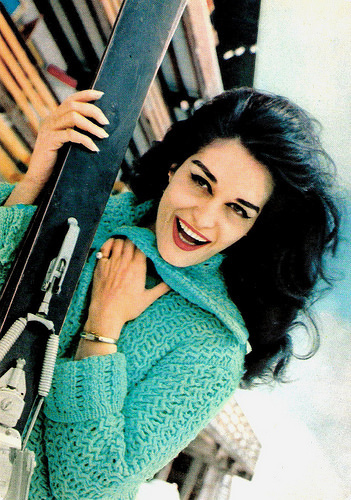
French postcard by Editions P.I., no. 1048. Photo: Noa.
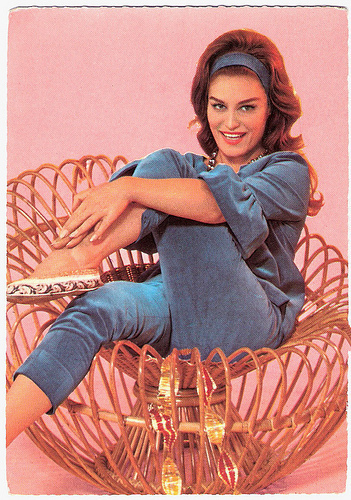
German postcard by Krüger, no. 902/183. Photo: Ariola.
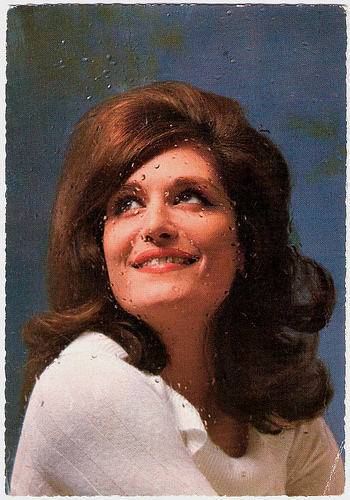
French postcard by E.D.U.G., no. 444. Photo: Barclay / Herman Léonard.
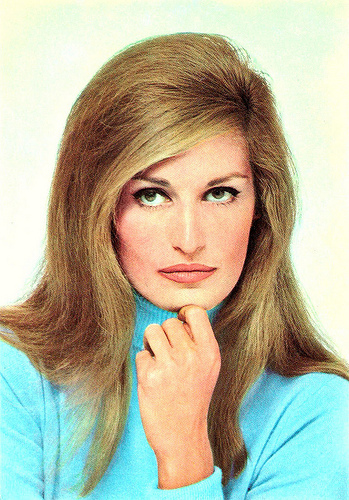
Italian postcard. Photo: RCA.
The Egyptian Version of Hollywood
Iolanda Cristina Gigliotti was born in Cairo, Egypt in 1933 in a middle-class family. Her family was of Italian origin, her parents having emigrated at the turn of the century from Calabria, Italy. She was the middle child between two brothers, Orlando and Bruno, who would later in Dalida's career change his name to Orlando like his other brother and become her manager. Dalida’s father, Pietro Gigliotti, was first violinist (primo violino) at the Cairo Opera House.
Dalida’s early life was spent in the district of Shoubra, where she attended the Scuola Tecnica Commerciale Maria Ausiliatrice, an Italian Catholic school.
In 1950, Dalida participated in the Miss Ondine beauty pageant and won the title, and shortly after began working as a model for Donna, a Cairo-based fashion house. At the age of 20, Dalida won the Miss Egypt pageant.
The doors of the Cairo film industry, the Egyptian version of Hollywood, opened wide before her. She was cast as a sultry brunette vamp in the film Sigara wa Kass/A Cigarette and a Glass (Niazi Mostafa, 1954).
She was spotted by French director Marc de Gastyne, who he gave her a role in his film Le Masque de Toutankhamon/The Mask of Tutankhamun (Marc de Gastyne, 1954).
Much to the reluctance of her parents, she moved to Paris on Christmas Eve of the same year with the intention of pursuing a film career. It was about this time she adopted the name Dalila, which was shortly thereafter changed to the more familiar Dalida.
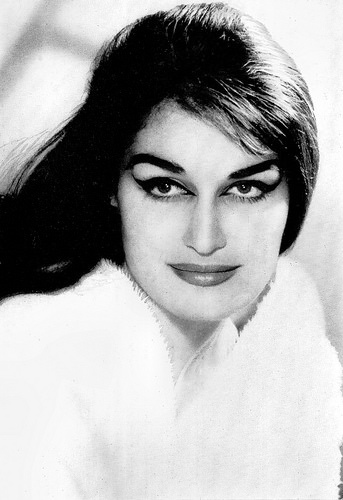
German postcard, no. 539.
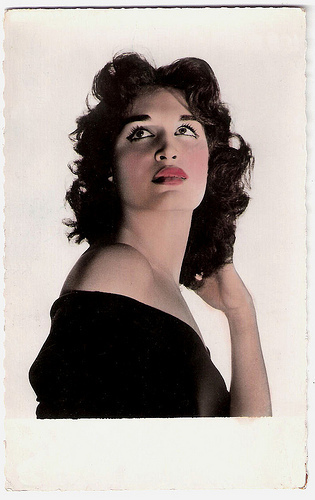
French postcard by Editions P.I., Paris, no. 905. Photo: Sam Lévin .
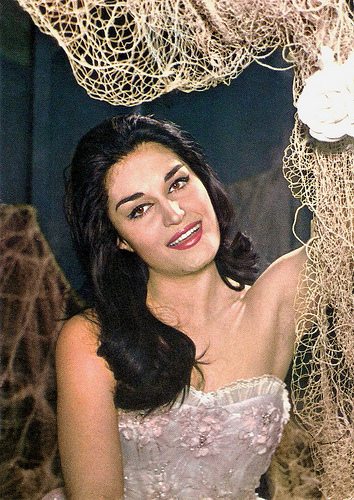
Italian postcard by Rotalfoto, Milano, no. N 122.
Ciao Ciao Bambina
Dalida’s quest for a career in French cinema proved to be no success.
Instead, she began taking singing lessons, and was booked as a cabaret act on the Champs Élysées, which proved successful.
Performing the song Étrangère au Paradis (Stranger in Paradise) in a variety show at the Paris Olympia theatre, Dalida was introduced to Lucien Morisse and Eddie Barclay, who played a considerable part in launching the starlet’s career.
Morisse was artistic producer of the popular Radio Europe 1, and Barclay was an established record producer. After signing a recording contract with Barclay, Dalida’s debut single Madona was promoted heavily by Morisse, and was a moderate success.
However, the release of Bambino in 1956 would prove to be even more triumphant - it spent 46 weeks in the French top ten and remains one of the biggest-selling singles in French history, and for its sales (which exceeded 300,000 copies) Dalida was awarded her first gold disc in 1957.
In the same year, she would also support Charles Aznavour at the Olympia. The follow up single to Bambino, the exotic-sounding Gondolier was also a great success, as were other early releases such as Come Prima (Tu Me Donnes), Ciao Ciao Bambina, and a cover of The Drifters’ Save the Last Dance For Me, Garde-Moi la Dernière Danse.
Dalida would perform and record in more than 10 languages including: French, Italian, Arabic, German, Spanish, English, Dutch, Japanese, Hebrew, and Greek. She collected 19 international number one hit singles to her name, spanning over forty years. Worldwide sales of her music are estimated at over 130 million, establishing her as one of the most noteworthy multi-lingual recording artists of the twentieth century.
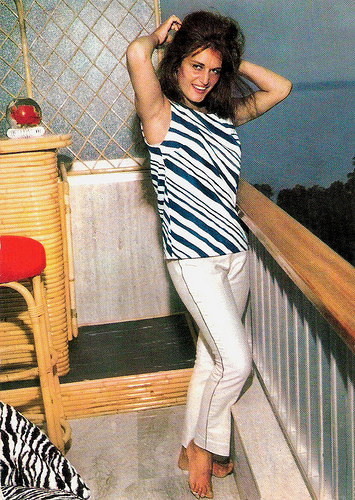
French postcard by Editions P.I., no. 1108. Photo: Kasparian.
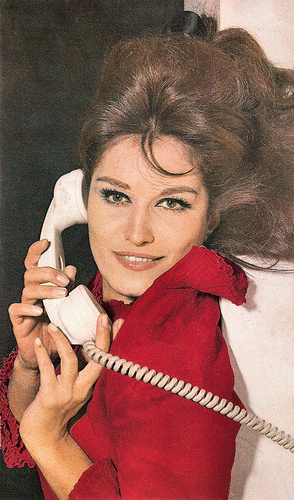
French postcard by E.D.U.G., presented by Corvisart, no. 293. Photo: Herman Leonard.

French postcard by E.D.U.G., no. 148. Photo: Sam Lévin.
Gigi l’Amoroso
Dalida incidentally appeared in such French films as Brigade des mœurs (Maurice Boutel, 1958), Rapt au deuxième bureau/Operation Abduction (Jean Stelli, 1958) and Che femmina... e che dollari!/Parlez-moi d'amour (Giorgio Simonelli, 1960) with Jacques Sernas .
She toured extensively through Europe, Egypt and the United States from 1958 through the early 1960s, and Dalida soon became well-known throughout Europe. However, her tour of America was less successful and fame eluded her in English-speaking markets.
In 1961, Dalida performed a month of shows at the Olympia, with each selling out completely. Shortly afterwards Dalida embarked upon a tour of Hong Kong and Vietnam. Throughout the 1960s Dalida would frequently perform sell-out shows at the Olympia, and international dates became more frequent.
She also starred in films like L'inconnue de Hong Kong/Stranger from Hong-Kong (Jacques Poitrenaud, 1963) opposite Serge Gainsbourg , and Menage all'italiana/Menage Italian Style (Franco Indovina, 1968) with Ugo Tognazzi .
In December 1968, she was awarded the Médaille de la Présidence de la République by Général de Gaulle, the only person from the music industry to have received this accolade.
The early 1970s became a transitional period for the singer, highlighted by some of her most successful singles. After gaining a keen interest in academia in the mid-1960s she chose to sing songs with more profound lyrics.
In 1973, a French version of the Italian song Paroles Paroles, originally performed by Mina , was recorded by Dalida and her close friend Alain Delon . The song became a big hit and was the number one single in France and Japan.
The follow up, Il Venait d’Avoir Dix-Huit Ans, reached number one in nine countries, and sold three and a half million copies in Germany.
Gigi l’Amoroso, released in 1974, would actually perform even better in the charts than its predecessor, reaching number one in 12 countries.
Touring would follow this period of unprecedented sales, with Dalida performing in Japan, Canada and Germany. In February 1975, French music critics presented the singer with the prestigious Prix de l'Académie du Disque Français.
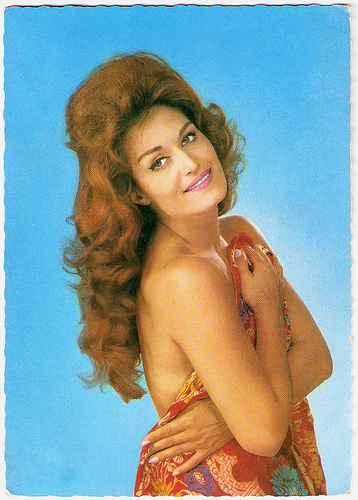
French postcard by E.D.U.G., no. 207. Photo: Sam Lévin / Disques Barclay.
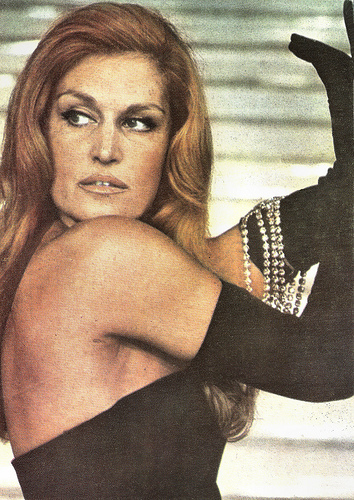
Romanian postcard by Casa Filmului Acin.
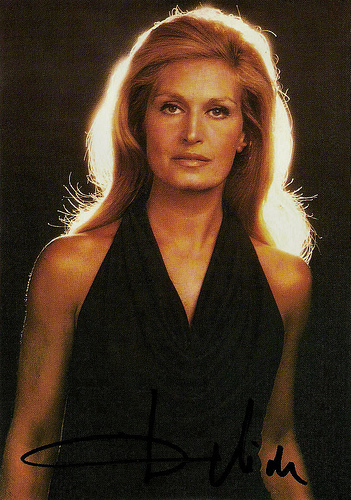
French postcard by Edition Lyna, Paris, no. 2017. Photo: A. Marouani.
Overdose of Barbiturates
1976 saw another career reinvention for Dalida; releasing what is widely regarded as the first French disco single, J’attendrai. Around the same time, the popularity of the variety show in France was soaring, and Dalida made many television appearances during this period, not only in France but across Europe.
One of her films was Comme sur des roulettes/As Easy as Pie (Nina Companéez, 1977). She had hits with the Arabic song Salma ya Salama and Génération ‘78, a disco-fused combination of her biggest hit singles to date. It also became the first French single to be accompanied by a video clip. During this disco period, Dalida would earn a gay audience, a following which is still maintained today.
In November, Dalida performed a Broadway-themed show at Carnegie Hall in New York, choreographed by Lester Wilson, who created the dance routines for John Travolta in the previous year’s cinema smash Saturday Night Fever (John Badham, 1977).
1981 marked the release of Rio do Brasil, and several dates were played at the Olympia, emulating her successful 1980 tour. On the night of her first performance she became the first singer in the world to be awarded with a diamond disc, in recognition of her record sales which at that point in her career had exceeded 86 million.
Her last album of completely new recordings was Le visage de l'amour (1986). Dalida underwent two major ophthalmic operations in 1985, forcing her to put her career on hiatus.
In 1986, she would play the role of a young grandmother in the French-Egyptian film Al-yawm al-Sadis/Le sixième jour/The Sixth Day (Youssef Chahine, 1986), for which she received favourable critical response.
Her last live performance, took place in Ankara, Turkey, in 1987. Despite enormous career success, Dalida’s private life was marred by a series of failed relationships and personal problems. Her first husband, Lucien Morisse, committed suicide several years after her divorce. Two of her lovers, Luigi Tenco and Richard Chanfray also took their own lives.
On 3 May 1987 Dalida died as a result of an overdose of barbiturates, leaving a suicide note reading "Life has become unbearable ... Forgive me." Dalida was buried in Cimetière de Montmartre (Montmartre Cemetery), Paris, and a life-size statue of her was erected outside her tomb.
In 2005, her life was documented in the two-part TV film Dalida (Joyce Buñuel, 2005), with Sabrina Ferilli and Christophe Lambert .
Dalida sings the Italian version of Bang Bang. Source: FilippoEdo (YouTube).
Dalida sings Gondolier. Source: Andreideathboy (YouTube).
Remix of Salma ya salama. Source: Tarxiri (YouTube).
Sources: RFI Musique (French), Wikipedia and .

French postcard by Editions P.I., no. 1048. Photo: Noa.

German postcard by Krüger, no. 902/183. Photo: Ariola.

French postcard by E.D.U.G., no. 444. Photo: Barclay / Herman Léonard.

Italian postcard. Photo: RCA.
The Egyptian Version of Hollywood
Iolanda Cristina Gigliotti was born in Cairo, Egypt in 1933 in a middle-class family. Her family was of Italian origin, her parents having emigrated at the turn of the century from Calabria, Italy. She was the middle child between two brothers, Orlando and Bruno, who would later in Dalida's career change his name to Orlando like his other brother and become her manager. Dalida’s father, Pietro Gigliotti, was first violinist (primo violino) at the Cairo Opera House.
Dalida’s early life was spent in the district of Shoubra, where she attended the Scuola Tecnica Commerciale Maria Ausiliatrice, an Italian Catholic school.
In 1950, Dalida participated in the Miss Ondine beauty pageant and won the title, and shortly after began working as a model for Donna, a Cairo-based fashion house. At the age of 20, Dalida won the Miss Egypt pageant.
The doors of the Cairo film industry, the Egyptian version of Hollywood, opened wide before her. She was cast as a sultry brunette vamp in the film Sigara wa Kass/A Cigarette and a Glass (Niazi Mostafa, 1954).
She was spotted by French director Marc de Gastyne, who he gave her a role in his film Le Masque de Toutankhamon/The Mask of Tutankhamun (Marc de Gastyne, 1954).
Much to the reluctance of her parents, she moved to Paris on Christmas Eve of the same year with the intention of pursuing a film career. It was about this time she adopted the name Dalila, which was shortly thereafter changed to the more familiar Dalida.

German postcard, no. 539.

French postcard by Editions P.I., Paris, no. 905. Photo: Sam Lévin .

Italian postcard by Rotalfoto, Milano, no. N 122.
Ciao Ciao Bambina
Dalida’s quest for a career in French cinema proved to be no success.
Instead, she began taking singing lessons, and was booked as a cabaret act on the Champs Élysées, which proved successful.
Performing the song Étrangère au Paradis (Stranger in Paradise) in a variety show at the Paris Olympia theatre, Dalida was introduced to Lucien Morisse and Eddie Barclay, who played a considerable part in launching the starlet’s career.
Morisse was artistic producer of the popular Radio Europe 1, and Barclay was an established record producer. After signing a recording contract with Barclay, Dalida’s debut single Madona was promoted heavily by Morisse, and was a moderate success.
However, the release of Bambino in 1956 would prove to be even more triumphant - it spent 46 weeks in the French top ten and remains one of the biggest-selling singles in French history, and for its sales (which exceeded 300,000 copies) Dalida was awarded her first gold disc in 1957.
In the same year, she would also support Charles Aznavour at the Olympia. The follow up single to Bambino, the exotic-sounding Gondolier was also a great success, as were other early releases such as Come Prima (Tu Me Donnes), Ciao Ciao Bambina, and a cover of The Drifters’ Save the Last Dance For Me, Garde-Moi la Dernière Danse.
Dalida would perform and record in more than 10 languages including: French, Italian, Arabic, German, Spanish, English, Dutch, Japanese, Hebrew, and Greek. She collected 19 international number one hit singles to her name, spanning over forty years. Worldwide sales of her music are estimated at over 130 million, establishing her as one of the most noteworthy multi-lingual recording artists of the twentieth century.

French postcard by Editions P.I., no. 1108. Photo: Kasparian.

French postcard by E.D.U.G., presented by Corvisart, no. 293. Photo: Herman Leonard.

French postcard by E.D.U.G., no. 148. Photo: Sam Lévin.
Gigi l’Amoroso
Dalida incidentally appeared in such French films as Brigade des mœurs (Maurice Boutel, 1958), Rapt au deuxième bureau/Operation Abduction (Jean Stelli, 1958) and Che femmina... e che dollari!/Parlez-moi d'amour (Giorgio Simonelli, 1960) with Jacques Sernas .
She toured extensively through Europe, Egypt and the United States from 1958 through the early 1960s, and Dalida soon became well-known throughout Europe. However, her tour of America was less successful and fame eluded her in English-speaking markets.
In 1961, Dalida performed a month of shows at the Olympia, with each selling out completely. Shortly afterwards Dalida embarked upon a tour of Hong Kong and Vietnam. Throughout the 1960s Dalida would frequently perform sell-out shows at the Olympia, and international dates became more frequent.
She also starred in films like L'inconnue de Hong Kong/Stranger from Hong-Kong (Jacques Poitrenaud, 1963) opposite Serge Gainsbourg , and Menage all'italiana/Menage Italian Style (Franco Indovina, 1968) with Ugo Tognazzi .
In December 1968, she was awarded the Médaille de la Présidence de la République by Général de Gaulle, the only person from the music industry to have received this accolade.
The early 1970s became a transitional period for the singer, highlighted by some of her most successful singles. After gaining a keen interest in academia in the mid-1960s she chose to sing songs with more profound lyrics.
In 1973, a French version of the Italian song Paroles Paroles, originally performed by Mina , was recorded by Dalida and her close friend Alain Delon . The song became a big hit and was the number one single in France and Japan.
The follow up, Il Venait d’Avoir Dix-Huit Ans, reached number one in nine countries, and sold three and a half million copies in Germany.
Gigi l’Amoroso, released in 1974, would actually perform even better in the charts than its predecessor, reaching number one in 12 countries.
Touring would follow this period of unprecedented sales, with Dalida performing in Japan, Canada and Germany. In February 1975, French music critics presented the singer with the prestigious Prix de l'Académie du Disque Français.

French postcard by E.D.U.G., no. 207. Photo: Sam Lévin / Disques Barclay.

Romanian postcard by Casa Filmului Acin.

French postcard by Edition Lyna, Paris, no. 2017. Photo: A. Marouani.
Overdose of Barbiturates
1976 saw another career reinvention for Dalida; releasing what is widely regarded as the first French disco single, J’attendrai. Around the same time, the popularity of the variety show in France was soaring, and Dalida made many television appearances during this period, not only in France but across Europe.
One of her films was Comme sur des roulettes/As Easy as Pie (Nina Companéez, 1977). She had hits with the Arabic song Salma ya Salama and Génération ‘78, a disco-fused combination of her biggest hit singles to date. It also became the first French single to be accompanied by a video clip. During this disco period, Dalida would earn a gay audience, a following which is still maintained today.
In November, Dalida performed a Broadway-themed show at Carnegie Hall in New York, choreographed by Lester Wilson, who created the dance routines for John Travolta in the previous year’s cinema smash Saturday Night Fever (John Badham, 1977).
1981 marked the release of Rio do Brasil, and several dates were played at the Olympia, emulating her successful 1980 tour. On the night of her first performance she became the first singer in the world to be awarded with a diamond disc, in recognition of her record sales which at that point in her career had exceeded 86 million.
Her last album of completely new recordings was Le visage de l'amour (1986). Dalida underwent two major ophthalmic operations in 1985, forcing her to put her career on hiatus.
In 1986, she would play the role of a young grandmother in the French-Egyptian film Al-yawm al-Sadis/Le sixième jour/The Sixth Day (Youssef Chahine, 1986), for which she received favourable critical response.
Her last live performance, took place in Ankara, Turkey, in 1987. Despite enormous career success, Dalida’s private life was marred by a series of failed relationships and personal problems. Her first husband, Lucien Morisse, committed suicide several years after her divorce. Two of her lovers, Luigi Tenco and Richard Chanfray also took their own lives.
On 3 May 1987 Dalida died as a result of an overdose of barbiturates, leaving a suicide note reading "Life has become unbearable ... Forgive me." Dalida was buried in Cimetière de Montmartre (Montmartre Cemetery), Paris, and a life-size statue of her was erected outside her tomb.
In 2005, her life was documented in the two-part TV film Dalida (Joyce Buñuel, 2005), with Sabrina Ferilli and Christophe Lambert .
Dalida sings the Italian version of Bang Bang. Source: FilippoEdo (YouTube).
Dalida sings Gondolier. Source: Andreideathboy (YouTube).
Remix of Salma ya salama. Source: Tarxiri (YouTube).
Sources: RFI Musique (French), Wikipedia and .
Published on July 08, 2014 23:00
July 7, 2014
Erna Morena
Although her name is now largely forgotten, beautiful Erna Morena (1885-1962) appeared in about 120 films during five decades. She had an enormous career in the German silent cinema of the 1910s and 1920s as both an actress, producer and screenwriter, and until the mid-1930s she was regularly performing in German sound films.
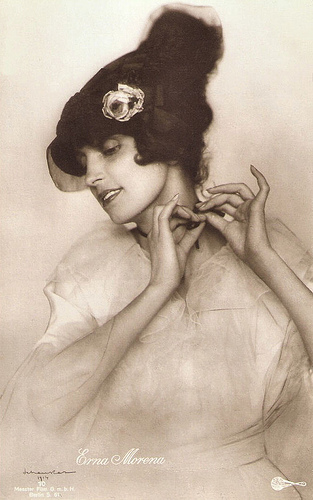
German postcard by Messter Film GmbH. Photo: Schenker, 1914.
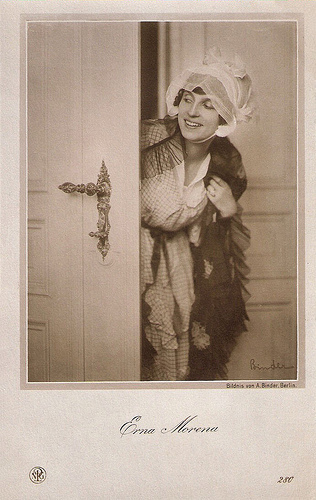
German postcard by NPG, no. 280. Photo: A. (Alex) Binder, Berlin.
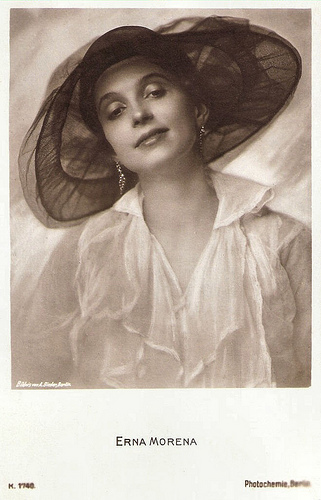
German postcard by Photochemie, Berlin, no. K. 1740. Photo: Alex Binder, Berlin.
Bewildered by her Subtle Performance
Erna Morena was born Ernestine Maria Fuchs in a bourgeois family in Wörth am Main, Germany, in 1885.
At the age of 17, she went to München (Munich) to attend the Kunstgewerbeschule (art school). Later, she spent six months in Paris, until finally at the end of the first decade she moved to Berlin and worked there as a nurse.
Morena started her acting career at the Schauspielschule des Deutschen Theaters (the acting school of the German Theatre) in 1910/1911 and swiftly got an engagement at the Ensemble Max Reinhardt.
She made her film debut in 1913. Her first film was Sphynx/The Sphinx (Eugen Illés, 1913), and she went on to play in several more dramas by Eugen Illés for the Duskes company.
In 1914, she moved to the Messter Film company, where she appeared with Emil Jannings and Theodoor Loos in Arme Eva/Poor Eva (Robert Wiene, 1914) and with Hella Moja in Die weiße Rose/The White Rose (Franz Hofer, 1915).
All her Messter-films were distributed under the trademark of 'Erna Morena Film Serie', rivalling the series of Asta Nielsen and Henny Porten .
Around 1917 she moved to PAGU, where she starred in and adaptation of Franz Wedekind's play Lulu (Alexander Antalffy, 1917) opposite Harry Liedtke and Emil Jannings , and in Paul Leni's Prima Vera (Paul Leni, 1917), based on Alexandre Dumas' La dame aux camélias (Camille). Critics were bewildered by her subtle performance.
From 1915 to 1921 she was married to editor and stage author Wilhelm Herzog, who had also invented her stage name Erna Morena.
Morena also dabbled as a producer: in 1918 she founded in Berlin, Erna Morena Film GmbH, supported by some friends as partners. She produced films like Colomba (1918) with Werner Krauss , and Die 999. Nacht/The 999th Night (1919/1920) with Hans Albers . Because of the economic crisis after the November revolution, she had to stop producing after two years.
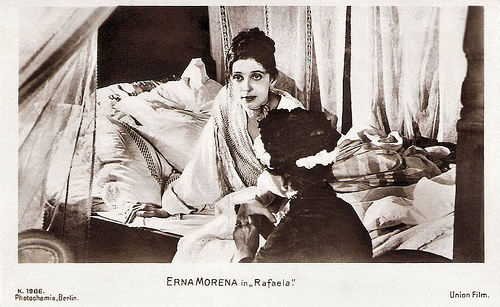
German postcard by Photochemie, Berlin, no. K. 1986. Photo: Union-Film. Publicity still of Erna Morena in Rafaela/Wer weiss? (Arsen von Cserépy, 1917).
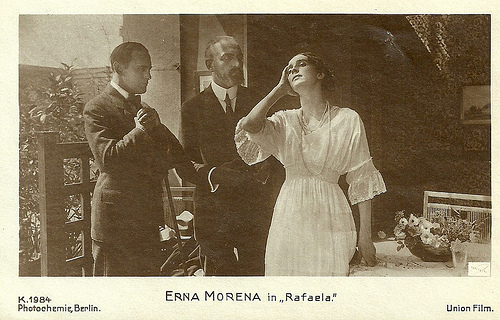
German postcard by Photochemie, Berlin, no. K. 1984. Photo: Union-Film. Publicity still of Erna Morena, Harry Liedtke and Magnus Stifter in Rafaela/Wer weiss? (Arsen von Cserépy, 1917).
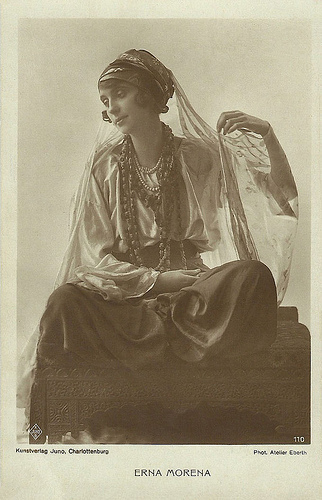
German postcard by Kunstverlag Juno, Charlottenburg, no. 110. Photo: Atelier Eberth. Collection: Didier Hanson.
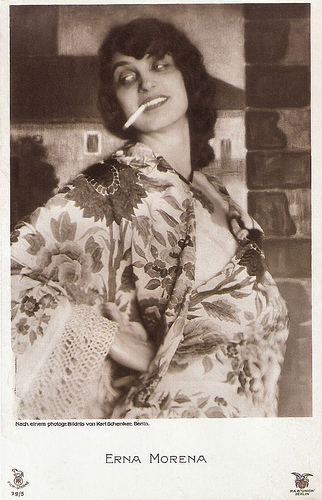
German postcard in the Film Sterne Series by Rotophot, no. 79/5. Photo: Karl Schenker, Berlin / P.A.G. Union. Collection: Didier Hanson.
Her Long Neck and Dark Looks
Erna Morena was one of the most unusual stars of the silent German cinema. Dark-haired, tall and with distinctive facial features, she had a star appeal as later Greta Garbo had.
Morena was most successful with her films by director Richard Oswald in the late 1910s and early 1920s, such as Das Tagebuch einer Verlorenen/Diary of a Lost Woman (Richard Oswald, 1918) a forerunner of the version by Georg Wilhelm Pabst, and the horror film Nachtgestalten/Figures of the Night (1920) starring Paul Wegener .
She also starred in some classic Expressionist films including Nerven/Nerves (Robert Reinert, 1919), Von morgens bis Mitternacht/From Morn to Midnight (Karl Heinz Martin, 1920) with Ernst Deutsch, and Der Gang in die Nacht/The Dark Road (F.W. Murnau, 1921) with Olaf Fönss and Conrad Veidt .
With her long neck and dark looks she often played exotic beauties, as in Die Lieblingsfrau des Maharadscha, 3./The Favorite Wife of the Maharadjah (Max Mack, 1921), and Das Indische Grabmal, 1. and 2./The Indian Tomb (Joe May, 1921), but also regal beauties in historical dramas as Fridericus Rex 1., 2., 3. and 4. (Arzén von Cserépy, 1922-1923) with Otto Gebühr , Wallenstein 1. and 2. (Rolf Randolf, 1925), Bismarck 1. and 2. (Ernst Wendt, 1925), and Das Schicksal derer von Habsburg/The destiny of the Habsburgs (Rolf Raffé, 1928) in which she played Empress Elisabeth - Sissi.
Of course there were also contemporary set stories like Der Berg des Schicksals/The Mountain of Destiny (Arnold Fanck, 1924) with Luis Trenker , the film that inspired Leni Riefenstahl to pursue a career in film; Mutter und Kind/Mother and Child (Carl Froehlich, 1924); Man spielt nicht mit Liebe/One Does Not Play with Love (G.W. Pabst, 1926) starring Werner Krauss and Lili Damita ; Grand Hotel (Johannes Guter, 1927) with a script by Bela Balazs, and Somnambul/The Somnambulist (Adolf Trotz, 1929) with Fritz Kortner .
She even played in one Dutch film: De bruut/The brute (1922) directed by Theo Frenkel, who had an active career in Germany in the 1920s; and in the French film, Le fauteuil 47/ Chair nr. 47 (Gaston Ravel, 1926) with Dolly Davis .
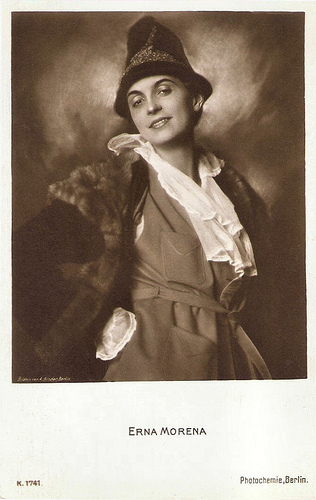
German postcard by Photochemie, no. K. 1741. Photo: Alex Binder, Berlin.
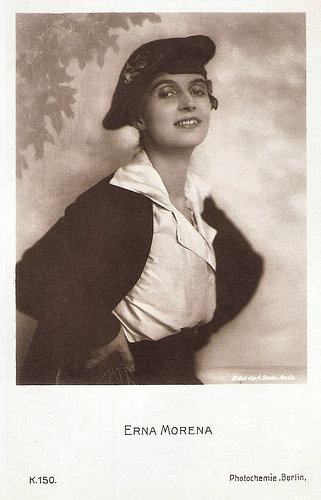
German postcard by Photochemie, Berlin, no. K. 150. Photo: Alex Binder, Berlin.
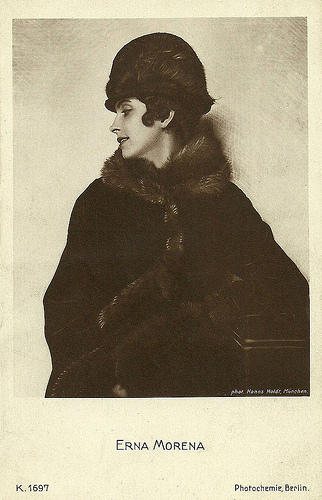
German postcard by Photchemie, Berlin, no. K. 1697. Photo: Hans Holdt, München. Collection: Didier Hanson.
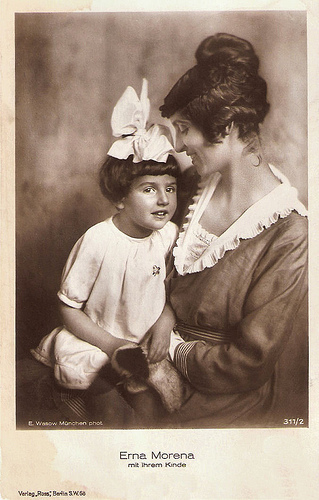
German postcard by Ross Verlag, Berlin, no. 311/2, 1919-1924. Photo: Wasow, München (Munich).
Heydays Over
Erna Morena seems to have made the passage to sound cinema quite smoothly as there was no big arrest in her number of film roles.
Still, from the young star and protagonist of the films of the late-1910s and early 1920s she had to be satisfied now with playing mothers, secondary roles. Her heydays were over.
Among her more interesting films of this period are Das Lied der Nationen/The Song of the Nations (Rudolf Meinert, 1931) with Camilla Horn , Eine Nacht im Paradies/A Night in Paradise (Carl Lamac, 1932) starring Anny Ondra, Drei Kaiserjäger/Three Imperial Light Infantrymen (Franz Hofer, Robert Land, 1933), and the operetta Abschiedswalzer/Farewell Waltz (Géza von Bolváry, 1934).
In the mid-1930s, she opened a pension for artists in München (Munich), and only returned to the film set for small parts in a handful of films, including the notorious Jud Süss ( Veit Harlan , 1940).
After the war she appeared in only one film, Veit Harlan 's Unsterbliche Geliebte/Eternal Beloved (1951), an emblematic title as the film meant Morena's goodbye.
One decade later, Erna Morena died in München, in 1962. Between 1913 and 1951 she had appeared in about 120 films. She had a daughter, Eva-Maria Herzog.
In 2006 filmmakers Bettina Neuhaus and Natasja Giebels made a poetic film portrait about the life story and personality of Erna Morena, Schwarzer Schwan/Black Swan.
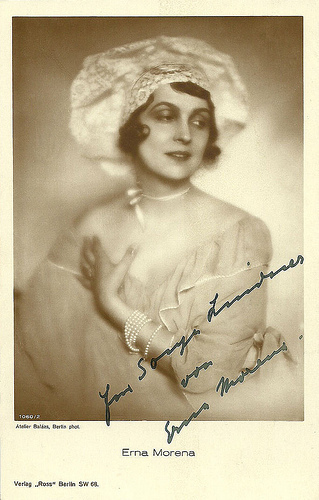
German postcard by Ross Verlag, nr. 1060/2, 1927-1928. Photo: Atelier Balázs, Berlin. Collection: Didier Hanson.
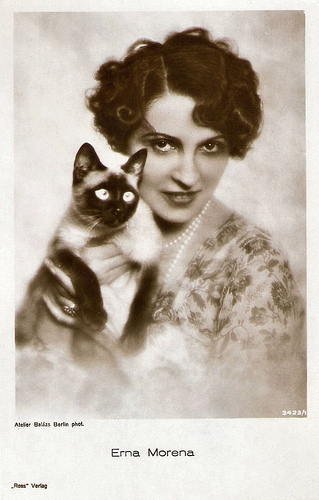
German postcard by Ross Verlag, no. 3423/1, 1928-1929. Photo: Atelier Balázs, Berlin.
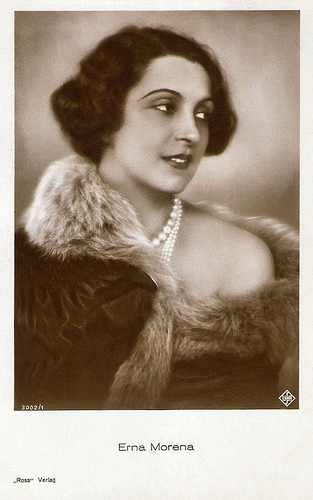
German postcard by Ross Verlag, no. 3002/1, 1928-1929. Photo: Ufa.
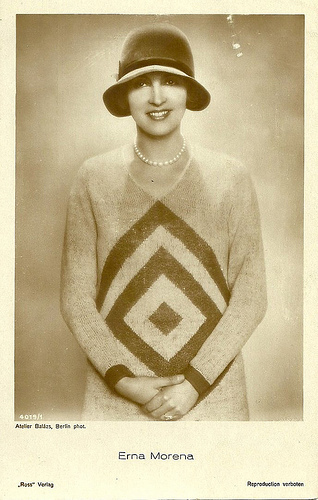
German postcard by Ross Verlag, no. 4019/1, 1929-1930. Photo: Atelier Balazs, Berlin.
Sources: Thomas Staedeli (Cyranos), Filmportal.de, Wikipedia (German) and .

German postcard by Messter Film GmbH. Photo: Schenker, 1914.

German postcard by NPG, no. 280. Photo: A. (Alex) Binder, Berlin.

German postcard by Photochemie, Berlin, no. K. 1740. Photo: Alex Binder, Berlin.
Bewildered by her Subtle Performance
Erna Morena was born Ernestine Maria Fuchs in a bourgeois family in Wörth am Main, Germany, in 1885.
At the age of 17, she went to München (Munich) to attend the Kunstgewerbeschule (art school). Later, she spent six months in Paris, until finally at the end of the first decade she moved to Berlin and worked there as a nurse.
Morena started her acting career at the Schauspielschule des Deutschen Theaters (the acting school of the German Theatre) in 1910/1911 and swiftly got an engagement at the Ensemble Max Reinhardt.
She made her film debut in 1913. Her first film was Sphynx/The Sphinx (Eugen Illés, 1913), and she went on to play in several more dramas by Eugen Illés for the Duskes company.
In 1914, she moved to the Messter Film company, where she appeared with Emil Jannings and Theodoor Loos in Arme Eva/Poor Eva (Robert Wiene, 1914) and with Hella Moja in Die weiße Rose/The White Rose (Franz Hofer, 1915).
All her Messter-films were distributed under the trademark of 'Erna Morena Film Serie', rivalling the series of Asta Nielsen and Henny Porten .
Around 1917 she moved to PAGU, where she starred in and adaptation of Franz Wedekind's play Lulu (Alexander Antalffy, 1917) opposite Harry Liedtke and Emil Jannings , and in Paul Leni's Prima Vera (Paul Leni, 1917), based on Alexandre Dumas' La dame aux camélias (Camille). Critics were bewildered by her subtle performance.
From 1915 to 1921 she was married to editor and stage author Wilhelm Herzog, who had also invented her stage name Erna Morena.
Morena also dabbled as a producer: in 1918 she founded in Berlin, Erna Morena Film GmbH, supported by some friends as partners. She produced films like Colomba (1918) with Werner Krauss , and Die 999. Nacht/The 999th Night (1919/1920) with Hans Albers . Because of the economic crisis after the November revolution, she had to stop producing after two years.

German postcard by Photochemie, Berlin, no. K. 1986. Photo: Union-Film. Publicity still of Erna Morena in Rafaela/Wer weiss? (Arsen von Cserépy, 1917).

German postcard by Photochemie, Berlin, no. K. 1984. Photo: Union-Film. Publicity still of Erna Morena, Harry Liedtke and Magnus Stifter in Rafaela/Wer weiss? (Arsen von Cserépy, 1917).

German postcard by Kunstverlag Juno, Charlottenburg, no. 110. Photo: Atelier Eberth. Collection: Didier Hanson.

German postcard in the Film Sterne Series by Rotophot, no. 79/5. Photo: Karl Schenker, Berlin / P.A.G. Union. Collection: Didier Hanson.
Her Long Neck and Dark Looks
Erna Morena was one of the most unusual stars of the silent German cinema. Dark-haired, tall and with distinctive facial features, she had a star appeal as later Greta Garbo had.
Morena was most successful with her films by director Richard Oswald in the late 1910s and early 1920s, such as Das Tagebuch einer Verlorenen/Diary of a Lost Woman (Richard Oswald, 1918) a forerunner of the version by Georg Wilhelm Pabst, and the horror film Nachtgestalten/Figures of the Night (1920) starring Paul Wegener .
She also starred in some classic Expressionist films including Nerven/Nerves (Robert Reinert, 1919), Von morgens bis Mitternacht/From Morn to Midnight (Karl Heinz Martin, 1920) with Ernst Deutsch, and Der Gang in die Nacht/The Dark Road (F.W. Murnau, 1921) with Olaf Fönss and Conrad Veidt .
With her long neck and dark looks she often played exotic beauties, as in Die Lieblingsfrau des Maharadscha, 3./The Favorite Wife of the Maharadjah (Max Mack, 1921), and Das Indische Grabmal, 1. and 2./The Indian Tomb (Joe May, 1921), but also regal beauties in historical dramas as Fridericus Rex 1., 2., 3. and 4. (Arzén von Cserépy, 1922-1923) with Otto Gebühr , Wallenstein 1. and 2. (Rolf Randolf, 1925), Bismarck 1. and 2. (Ernst Wendt, 1925), and Das Schicksal derer von Habsburg/The destiny of the Habsburgs (Rolf Raffé, 1928) in which she played Empress Elisabeth - Sissi.
Of course there were also contemporary set stories like Der Berg des Schicksals/The Mountain of Destiny (Arnold Fanck, 1924) with Luis Trenker , the film that inspired Leni Riefenstahl to pursue a career in film; Mutter und Kind/Mother and Child (Carl Froehlich, 1924); Man spielt nicht mit Liebe/One Does Not Play with Love (G.W. Pabst, 1926) starring Werner Krauss and Lili Damita ; Grand Hotel (Johannes Guter, 1927) with a script by Bela Balazs, and Somnambul/The Somnambulist (Adolf Trotz, 1929) with Fritz Kortner .
She even played in one Dutch film: De bruut/The brute (1922) directed by Theo Frenkel, who had an active career in Germany in the 1920s; and in the French film, Le fauteuil 47/ Chair nr. 47 (Gaston Ravel, 1926) with Dolly Davis .

German postcard by Photochemie, no. K. 1741. Photo: Alex Binder, Berlin.

German postcard by Photochemie, Berlin, no. K. 150. Photo: Alex Binder, Berlin.

German postcard by Photchemie, Berlin, no. K. 1697. Photo: Hans Holdt, München. Collection: Didier Hanson.

German postcard by Ross Verlag, Berlin, no. 311/2, 1919-1924. Photo: Wasow, München (Munich).
Heydays Over
Erna Morena seems to have made the passage to sound cinema quite smoothly as there was no big arrest in her number of film roles.
Still, from the young star and protagonist of the films of the late-1910s and early 1920s she had to be satisfied now with playing mothers, secondary roles. Her heydays were over.
Among her more interesting films of this period are Das Lied der Nationen/The Song of the Nations (Rudolf Meinert, 1931) with Camilla Horn , Eine Nacht im Paradies/A Night in Paradise (Carl Lamac, 1932) starring Anny Ondra, Drei Kaiserjäger/Three Imperial Light Infantrymen (Franz Hofer, Robert Land, 1933), and the operetta Abschiedswalzer/Farewell Waltz (Géza von Bolváry, 1934).
In the mid-1930s, she opened a pension for artists in München (Munich), and only returned to the film set for small parts in a handful of films, including the notorious Jud Süss ( Veit Harlan , 1940).
After the war she appeared in only one film, Veit Harlan 's Unsterbliche Geliebte/Eternal Beloved (1951), an emblematic title as the film meant Morena's goodbye.
One decade later, Erna Morena died in München, in 1962. Between 1913 and 1951 she had appeared in about 120 films. She had a daughter, Eva-Maria Herzog.
In 2006 filmmakers Bettina Neuhaus and Natasja Giebels made a poetic film portrait about the life story and personality of Erna Morena, Schwarzer Schwan/Black Swan.

German postcard by Ross Verlag, nr. 1060/2, 1927-1928. Photo: Atelier Balázs, Berlin. Collection: Didier Hanson.

German postcard by Ross Verlag, no. 3423/1, 1928-1929. Photo: Atelier Balázs, Berlin.

German postcard by Ross Verlag, no. 3002/1, 1928-1929. Photo: Ufa.

German postcard by Ross Verlag, no. 4019/1, 1929-1930. Photo: Atelier Balazs, Berlin.
Sources: Thomas Staedeli (Cyranos), Filmportal.de, Wikipedia (German) and .
Published on July 07, 2014 23:00
July 6, 2014
Jean Servais
Belgian actor Jean Servais (1910-1976) was a leading man of French films of the 1930s. He reverted to melancholy-looking character parts in the 1950s. When he played a tough gang-leader in the landmark caper film Du rififi chez les hommes/Rififi (1955), he became again a star.
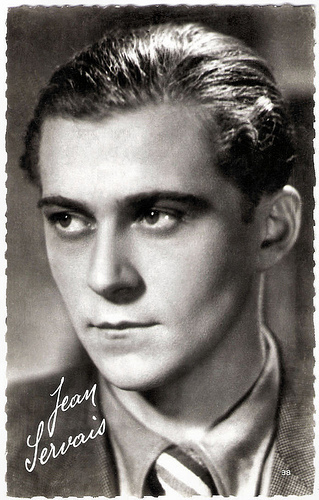
French postcard by Editions et Publications cinématographiques, no. 38.
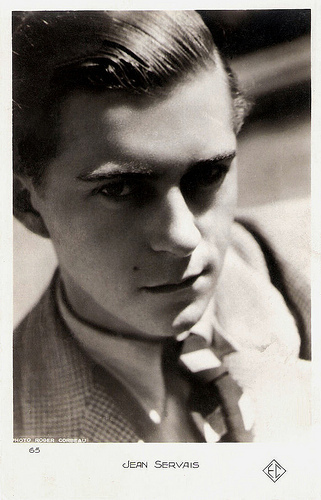
French postcard by EC, no. 65. Photo: Roger Corbeau.
Victim of an Error
Jean Servais was born in Antwerp, Belgium, in 1910.
He was trained for acting at the Brussels Conservatoire (Brussels Conservatory of Dramatic Arts), where he won the Second Prize.
His acting skills came to the attention of Raymond Rouleau, and he was hired at the Théâtre du Marais, where he acted in Le mal de jeunesse, which was successful in Brussels and in Paris.
Later he was a member of Jean-Louis Barrault 's theatre company for a time.
His first film role was as the simple country dweller who was the victim of an error by the justice system in Criminel/Criminal (Jack Forrester, 1932).
He had his breakthrough as Marius in a classic version of Les Misérables (Raymond Bernard, 1934) starring Harry Baur as Jean Valjean.
Other popular films were Jeunesse/Youth (Georges Lacombe, 1933), Angèle/Heartbeat (Marcel Pagnol, 1934) with Orane Demazis and Fernandel , and La Vie Est Magnifique/Life is wonderful (Maurice Cloche, 1938)
His film career was interrupted for several years by the Second World War. By the time he had returned before the cameras in 1946, he had acquired a brooding, haunted demeanor which lingered until the end of his days.
He played supporting roles Une si jolie petite plage (Yves Allégret, 1948) starring Gérard Philipe , and Le Plaisir (Max Ophüls, 1952), based on the stories by Guy de Maupassant.
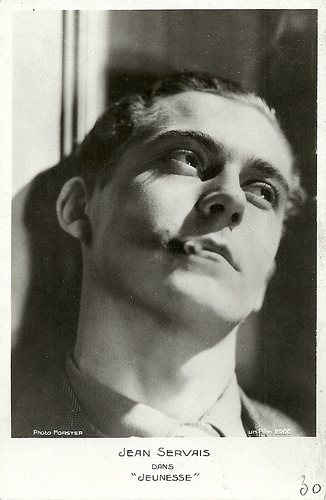
French postcard. Photo: Forster / Films Epoc. Jean Servais in the film Jeunesse (Georges Lacombe, 1934),
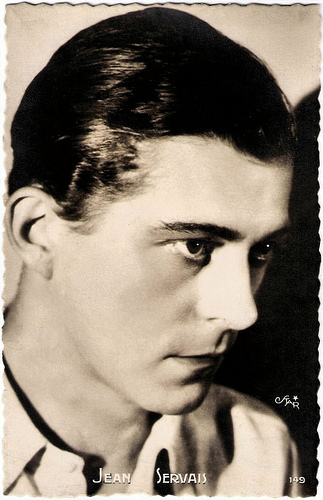
French postcard by O.P. Paris, no. 149. Photo: Star.
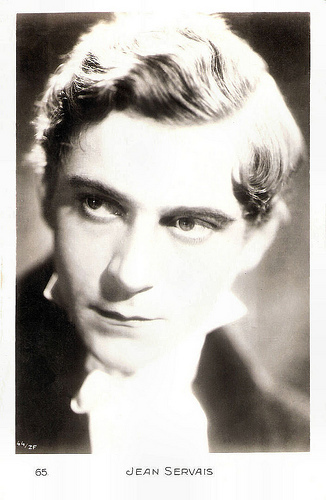
French postcard by Deshairs, Grenoble, no. 65.
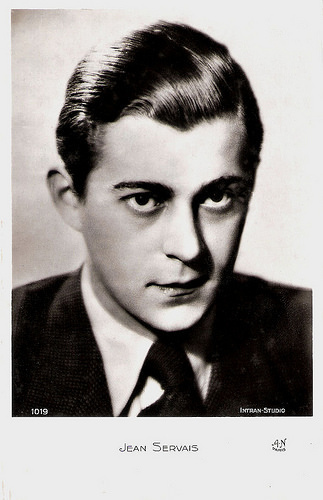
French postcard by A.N., Paris, no. 1019. Photo: Intran Studio.
Major Stardom
Jean Servais achieved major stardom in mid-life in Du rififi chez les hommes/Rififi (Jules Dassin, 1955), in which he played the tough, straight-talking leader of a gang of jewel thieves.
This crime drama about the planning and execution of a nighttime robbery at a swanky English jewelry shop in the Rue de Rivoli is seen by many critics as a landmark caper film.
Lucia Bozzola at AllMovie : "The pinnacle of heist movies, blacklistee Jules Dassin's Du Rififi Chez Les Hommes (1955) is not only one of the best French noirs, but one of the top movies in the genre. Crafting an archetypal noir story about how human weakness can sabotage the best-laid."
Du rififi chez les hommes/Rififi became an oft-imitated international hit and Jules Dassin won an award at the Cannes Film Festivan for his direction.
Servais and Dassin reunited for Celui qui doit mourir/He Who Must Die (Jules Dassin, 1957) with Carl Möhner and based on Nikos Kazantzakis's novel O Hristos Xanastavronetai.
Jean Servais is also known for his film association with such directors as Luis Bunuel (La fièvre monte à El Pao, 1959) and Georges Franju (Thomas l'imposteur, 1964).
In the 1960s, Servais took small character roles in popular international fare such as The Longest Day (Darryl F. Zanuck, 1962) and L’ homme de Rio/That Man from Rio (Philippe de Broca, 1964) starring Jean-Paul Belmondo .
In his last film, Le Protecteur/The Protector (Roger Hanin, 1974), he was a recently-released prisoner who tries to find his daughter who has fallen into the underworld of prostitution.
Jean Servais died of a heart failure in Paris, France, in 1976. He was married twice: to actress Dominique Blanchar and to Gilberte Graillot.
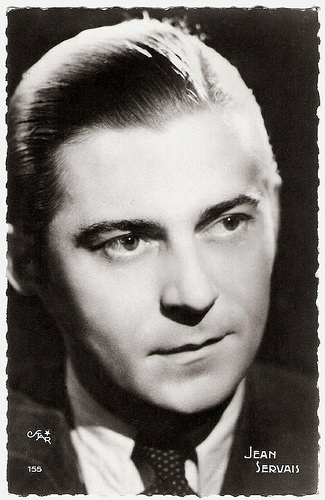
French postcard by Editions P.I., Paris, no. 155. Photo: Star.
French postcard by Editions P.I., Paris, no. 641, offered by Les Carbones Korès 'Carboplane'. Photo Studio Vallois.
Sources: Lucia Bozzola (AllMovie), AllMovie, and Wikipedia.

French postcard by Editions et Publications cinématographiques, no. 38.

French postcard by EC, no. 65. Photo: Roger Corbeau.
Victim of an Error
Jean Servais was born in Antwerp, Belgium, in 1910.
He was trained for acting at the Brussels Conservatoire (Brussels Conservatory of Dramatic Arts), where he won the Second Prize.
His acting skills came to the attention of Raymond Rouleau, and he was hired at the Théâtre du Marais, where he acted in Le mal de jeunesse, which was successful in Brussels and in Paris.
Later he was a member of Jean-Louis Barrault 's theatre company for a time.
His first film role was as the simple country dweller who was the victim of an error by the justice system in Criminel/Criminal (Jack Forrester, 1932).
He had his breakthrough as Marius in a classic version of Les Misérables (Raymond Bernard, 1934) starring Harry Baur as Jean Valjean.
Other popular films were Jeunesse/Youth (Georges Lacombe, 1933), Angèle/Heartbeat (Marcel Pagnol, 1934) with Orane Demazis and Fernandel , and La Vie Est Magnifique/Life is wonderful (Maurice Cloche, 1938)
His film career was interrupted for several years by the Second World War. By the time he had returned before the cameras in 1946, he had acquired a brooding, haunted demeanor which lingered until the end of his days.
He played supporting roles Une si jolie petite plage (Yves Allégret, 1948) starring Gérard Philipe , and Le Plaisir (Max Ophüls, 1952), based on the stories by Guy de Maupassant.

French postcard. Photo: Forster / Films Epoc. Jean Servais in the film Jeunesse (Georges Lacombe, 1934),

French postcard by O.P. Paris, no. 149. Photo: Star.

French postcard by Deshairs, Grenoble, no. 65.

French postcard by A.N., Paris, no. 1019. Photo: Intran Studio.
Major Stardom
Jean Servais achieved major stardom in mid-life in Du rififi chez les hommes/Rififi (Jules Dassin, 1955), in which he played the tough, straight-talking leader of a gang of jewel thieves.
This crime drama about the planning and execution of a nighttime robbery at a swanky English jewelry shop in the Rue de Rivoli is seen by many critics as a landmark caper film.
Lucia Bozzola at AllMovie : "The pinnacle of heist movies, blacklistee Jules Dassin's Du Rififi Chez Les Hommes (1955) is not only one of the best French noirs, but one of the top movies in the genre. Crafting an archetypal noir story about how human weakness can sabotage the best-laid."
Du rififi chez les hommes/Rififi became an oft-imitated international hit and Jules Dassin won an award at the Cannes Film Festivan for his direction.
Servais and Dassin reunited for Celui qui doit mourir/He Who Must Die (Jules Dassin, 1957) with Carl Möhner and based on Nikos Kazantzakis's novel O Hristos Xanastavronetai.
Jean Servais is also known for his film association with such directors as Luis Bunuel (La fièvre monte à El Pao, 1959) and Georges Franju (Thomas l'imposteur, 1964).
In the 1960s, Servais took small character roles in popular international fare such as The Longest Day (Darryl F. Zanuck, 1962) and L’ homme de Rio/That Man from Rio (Philippe de Broca, 1964) starring Jean-Paul Belmondo .
In his last film, Le Protecteur/The Protector (Roger Hanin, 1974), he was a recently-released prisoner who tries to find his daughter who has fallen into the underworld of prostitution.
Jean Servais died of a heart failure in Paris, France, in 1976. He was married twice: to actress Dominique Blanchar and to Gilberte Graillot.

French postcard by Editions P.I., Paris, no. 155. Photo: Star.
French postcard by Editions P.I., Paris, no. 641, offered by Les Carbones Korès 'Carboplane'. Photo Studio Vallois.
Sources: Lucia Bozzola (AllMovie), AllMovie, and Wikipedia.
Published on July 06, 2014 23:00
July 5, 2014
Jan & Kjeld
Jan and Kjeld Wennick were only 14 and 16 years old when they hit it big with their classic song Banjo Boy. In the early 1960s the two brothers from Copenhagen performed their hits in several Schlagerfilms.
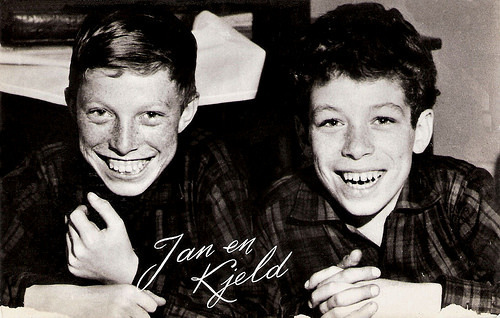
Dutch postcard by Uitg. Takken, Utrecht, no. AX 4372. Photo: CNR.
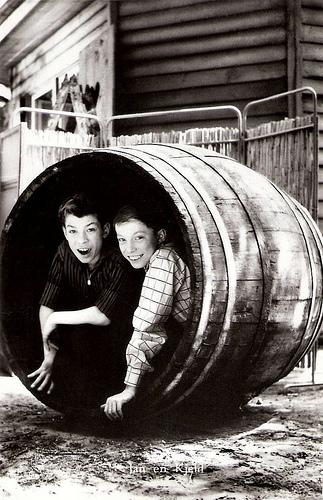
Dutch postcard by Hercules, Haarlem, no. 370. Photo for the film Marina, distributed in The Netherlands by Hafbo film.
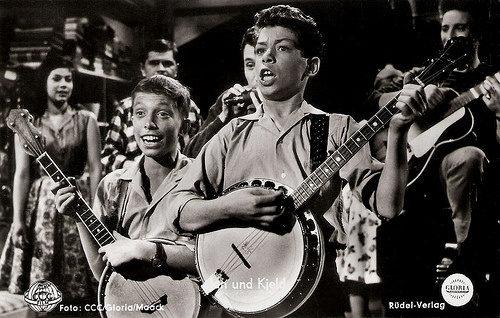
German postcard by Rüdel-Verlag, Hamburg-Bergedorf, no. 3126. Photo: CCC / Gloria / Maack. Publicity still for Marina (Paul Martin, 1960).
Left-handed
Kjeld Wennick (1944) was born in Gränna, Sweden, and his brother Jan (1946) in Copenhagen, Denmark.
At a young age Kjeld learned to play the banjo and from 1954 on he performed together with his father Svend. Jan often accompanied them and also learned to play the banjo.
In 1956 the duo Jan & Kjeld was formed. The boys won several song contests in Denmark, and soon they performed on radio and TV.
Their first record was a cover of Down by the Riverside.
In 1958 they made their film debut in the Danish family film Far til fire og ulveungerne/Father of Four Wolf Pups (Alice O'Fredericks, Robert Saaskin, 1958). The film was part of a popular film series about a single parent family featuring Karl Stegger as the father.
When they performed, Jan always stood at the left side. He was left-handed and so their banjos wouldn’t bump.
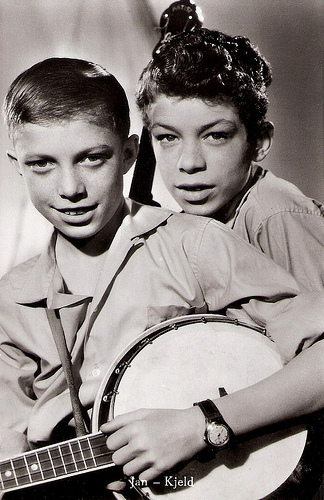
Dutch postcard by Hercules, Haarlem, no. 399.
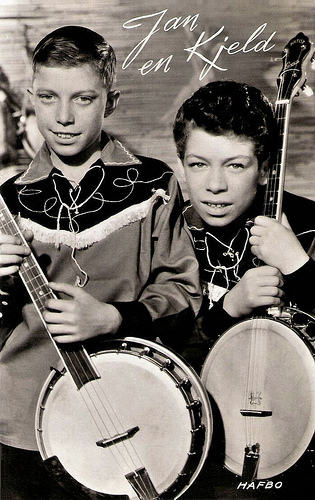
Dutch postcard by Uitg. Takken, Utrecht, no. AX 4542. Photo: Hafbo, the company which distributed their schlager film Marina (Paul Martin, 1960) in the Netherlands.
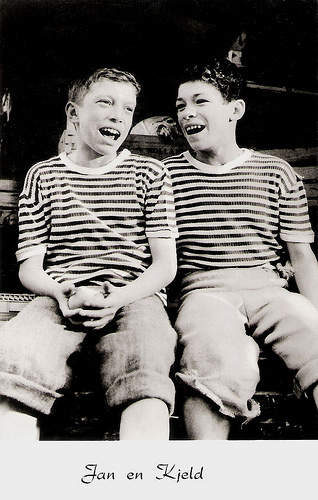
Dutch postcard, no. 5853.
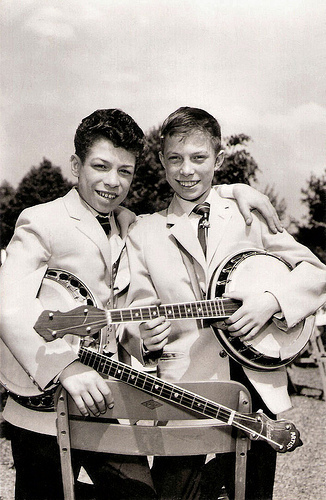
Dutch postcard by Gebr. Spanjersberg N.V., Rotterdam, no. 160 562.
Banjo Boy
In 1959, ‘The Kids from Copenhagen’ signed with Germany’s Ariola label and their first records were the covers Tom Dooley and Tiger Rag in 1959.
In the Dixieland classic Tiger Bay, Kjeld did a sensational scat in Louis Armstrong-style. The song became their first hit in Germany.
Their breakthrough was Banjo Boy (1959), which they sang in the film Kein Mann Zum Heiraten/No Man To Marry (Hans Deppe, 1959) with Marianne Hold .
Words and music for the song were written by Charly Niessen, who also composed songs for Peggy March and Hildegard Knef .
In Denmark (#1), Germany (#1), Holland (#4) and a lot of other countries Banjo Boy found the top 10. In Germany they sold 4,5 million copies of the record.
In 1960, American lyricist Buddy Kaye wrote English words for the song, and Banjo Boy reached #58 in the USA and #36 in Great Britain.
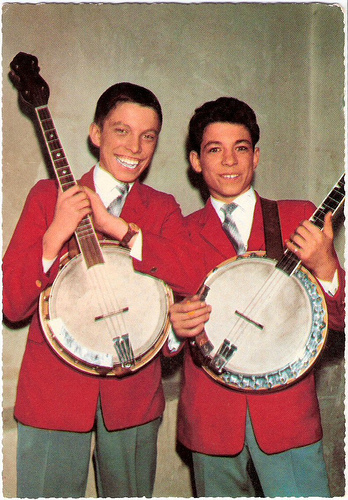
German postcard by ISV, no. K 14.
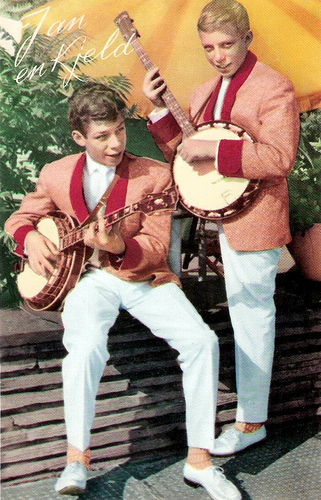
Dutch postcard.
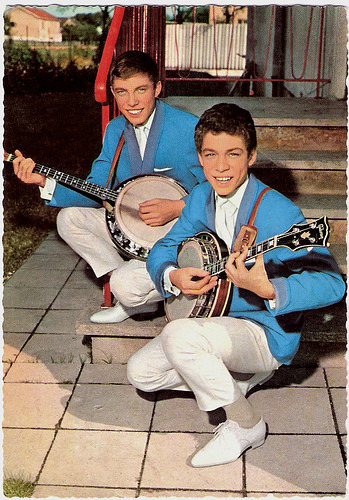
German postcard by Krüger, no. 902/182. Photo: Ariola.
Schlager Films
In Germany Jan & Kjeld became so popular that they played their songs in Schlagerfilms like Wir wollen niemals auseinandergehen/We Will Never Part (Harald Reinl, 1960), Gauner-Serenade/Rogue Serenade (Thomas Engel, 1960) and Marina (Paul Martin, 1960) with Giorgia Moll .
Till 1963 'Die Banjo Boys' had twelve more hits in Germany with German language covers such as the Ricky Nelson cover Hello Mary Lou, which was #2 in Germany in 1961.
In 1966 the singing career of the Danish teenagers was over but over the years they kept appearing in Golden Oldies shows.
Ten years later Jan & Kjeld tried a come-back with two disco songs in Danish: Så lyk'lige som vi (So Lucky We Are)(1976) and Det går op, det går ned (It Goes Up, It Goes Down)(1977). Then Jan retired from show business.
In 1983, Kjeld started his own music label, Mega Records, and enjoyed a world success with the the million-selling Swedish pop group Ace of Base. In 2001 he sold his label to Edel Records.
In 2003 he was a jury member of the Danish version of the TV talent show Idols and in 2005 he groomed celebrities to sing a song in the Danish game show Showtime.
Since 2006 Kjeld Wennick owns a café near the harbour of Copenhagen.
Jan & Kjeld sing Mach doch nicht immer soviel Wind in Kein Mann Zum Heiraten/No Man To Marry (Hans Deppe, 1959). Source: fritz51203 (YouTube).
Jan & Kjeld perform the Louis Armstrong classic Tiger Bay (1959). Source: Frans Jaspers (YouTube).
Jan & Kjeld sing Banjo Boy in Wir wollen niemals auseinandergehen/We Will Never Part (Harald Reinl, 1960). Source: Alleengoedwerk (YouTube).
Sources: De Duitse Schlager (Dutch), Wikipedia (German) and .

Dutch postcard by Uitg. Takken, Utrecht, no. AX 4372. Photo: CNR.

Dutch postcard by Hercules, Haarlem, no. 370. Photo for the film Marina, distributed in The Netherlands by Hafbo film.

German postcard by Rüdel-Verlag, Hamburg-Bergedorf, no. 3126. Photo: CCC / Gloria / Maack. Publicity still for Marina (Paul Martin, 1960).
Left-handed
Kjeld Wennick (1944) was born in Gränna, Sweden, and his brother Jan (1946) in Copenhagen, Denmark.
At a young age Kjeld learned to play the banjo and from 1954 on he performed together with his father Svend. Jan often accompanied them and also learned to play the banjo.
In 1956 the duo Jan & Kjeld was formed. The boys won several song contests in Denmark, and soon they performed on radio and TV.
Their first record was a cover of Down by the Riverside.
In 1958 they made their film debut in the Danish family film Far til fire og ulveungerne/Father of Four Wolf Pups (Alice O'Fredericks, Robert Saaskin, 1958). The film was part of a popular film series about a single parent family featuring Karl Stegger as the father.
When they performed, Jan always stood at the left side. He was left-handed and so their banjos wouldn’t bump.

Dutch postcard by Hercules, Haarlem, no. 399.

Dutch postcard by Uitg. Takken, Utrecht, no. AX 4542. Photo: Hafbo, the company which distributed their schlager film Marina (Paul Martin, 1960) in the Netherlands.

Dutch postcard, no. 5853.

Dutch postcard by Gebr. Spanjersberg N.V., Rotterdam, no. 160 562.
Banjo Boy
In 1959, ‘The Kids from Copenhagen’ signed with Germany’s Ariola label and their first records were the covers Tom Dooley and Tiger Rag in 1959.
In the Dixieland classic Tiger Bay, Kjeld did a sensational scat in Louis Armstrong-style. The song became their first hit in Germany.
Their breakthrough was Banjo Boy (1959), which they sang in the film Kein Mann Zum Heiraten/No Man To Marry (Hans Deppe, 1959) with Marianne Hold .
Words and music for the song were written by Charly Niessen, who also composed songs for Peggy March and Hildegard Knef .
In Denmark (#1), Germany (#1), Holland (#4) and a lot of other countries Banjo Boy found the top 10. In Germany they sold 4,5 million copies of the record.
In 1960, American lyricist Buddy Kaye wrote English words for the song, and Banjo Boy reached #58 in the USA and #36 in Great Britain.

German postcard by ISV, no. K 14.

Dutch postcard.

German postcard by Krüger, no. 902/182. Photo: Ariola.
Schlager Films
In Germany Jan & Kjeld became so popular that they played their songs in Schlagerfilms like Wir wollen niemals auseinandergehen/We Will Never Part (Harald Reinl, 1960), Gauner-Serenade/Rogue Serenade (Thomas Engel, 1960) and Marina (Paul Martin, 1960) with Giorgia Moll .
Till 1963 'Die Banjo Boys' had twelve more hits in Germany with German language covers such as the Ricky Nelson cover Hello Mary Lou, which was #2 in Germany in 1961.
In 1966 the singing career of the Danish teenagers was over but over the years they kept appearing in Golden Oldies shows.
Ten years later Jan & Kjeld tried a come-back with two disco songs in Danish: Så lyk'lige som vi (So Lucky We Are)(1976) and Det går op, det går ned (It Goes Up, It Goes Down)(1977). Then Jan retired from show business.
In 1983, Kjeld started his own music label, Mega Records, and enjoyed a world success with the the million-selling Swedish pop group Ace of Base. In 2001 he sold his label to Edel Records.
In 2003 he was a jury member of the Danish version of the TV talent show Idols and in 2005 he groomed celebrities to sing a song in the Danish game show Showtime.
Since 2006 Kjeld Wennick owns a café near the harbour of Copenhagen.
Jan & Kjeld sing Mach doch nicht immer soviel Wind in Kein Mann Zum Heiraten/No Man To Marry (Hans Deppe, 1959). Source: fritz51203 (YouTube).
Jan & Kjeld perform the Louis Armstrong classic Tiger Bay (1959). Source: Frans Jaspers (YouTube).
Jan & Kjeld sing Banjo Boy in Wir wollen niemals auseinandergehen/We Will Never Part (Harald Reinl, 1960). Source: Alleengoedwerk (YouTube).
Sources: De Duitse Schlager (Dutch), Wikipedia (German) and .
Published on July 05, 2014 23:00
Paul van Yperen's Blog
- Paul van Yperen's profile
- 13 followers
Paul van Yperen isn't a Goodreads Author
(yet),
but they
do have a blog,
so here are some recent posts imported from
their feed.



